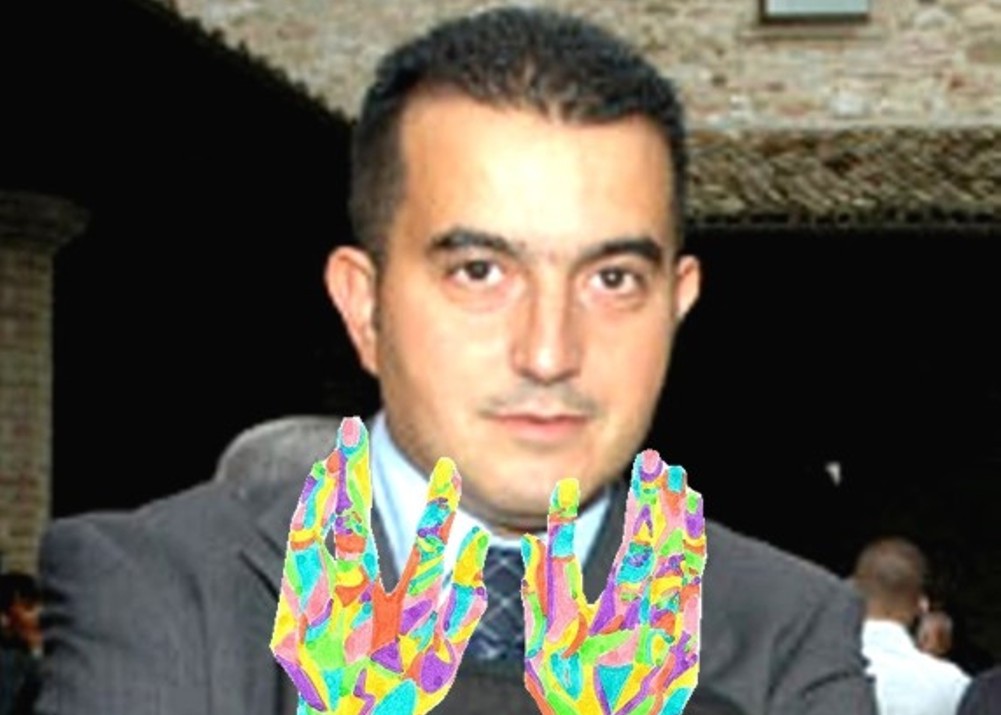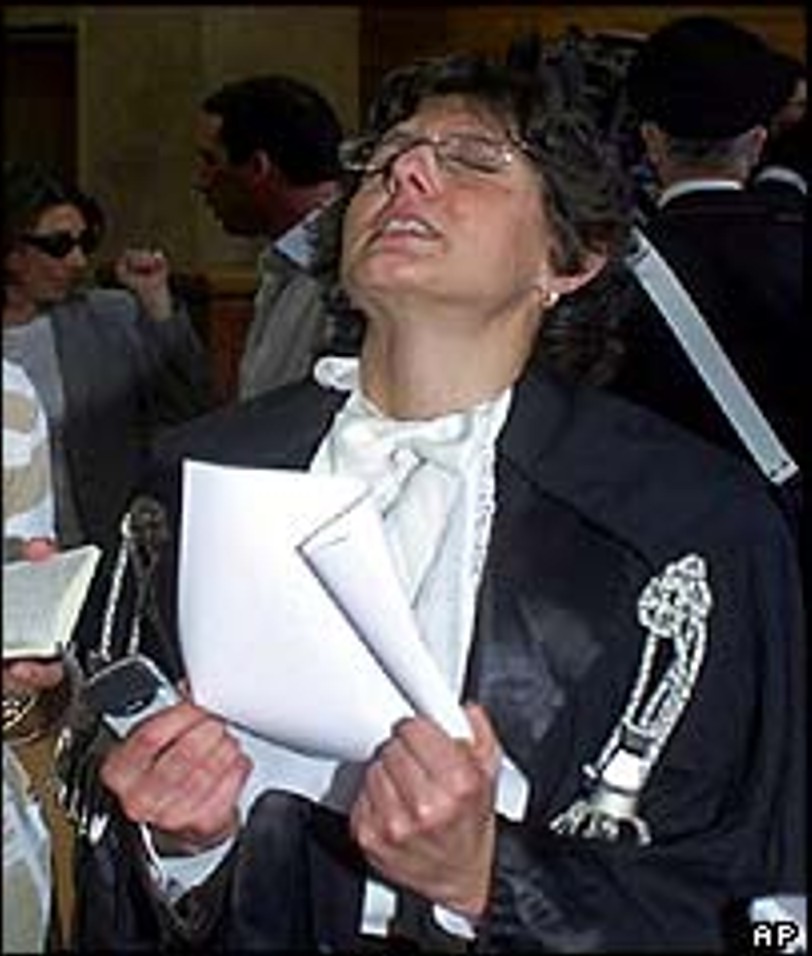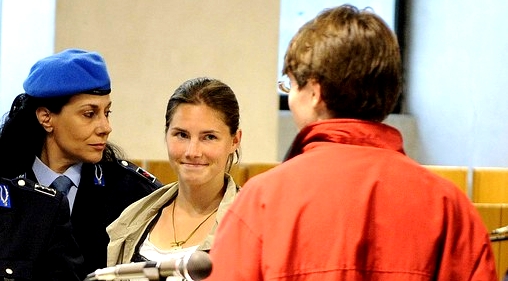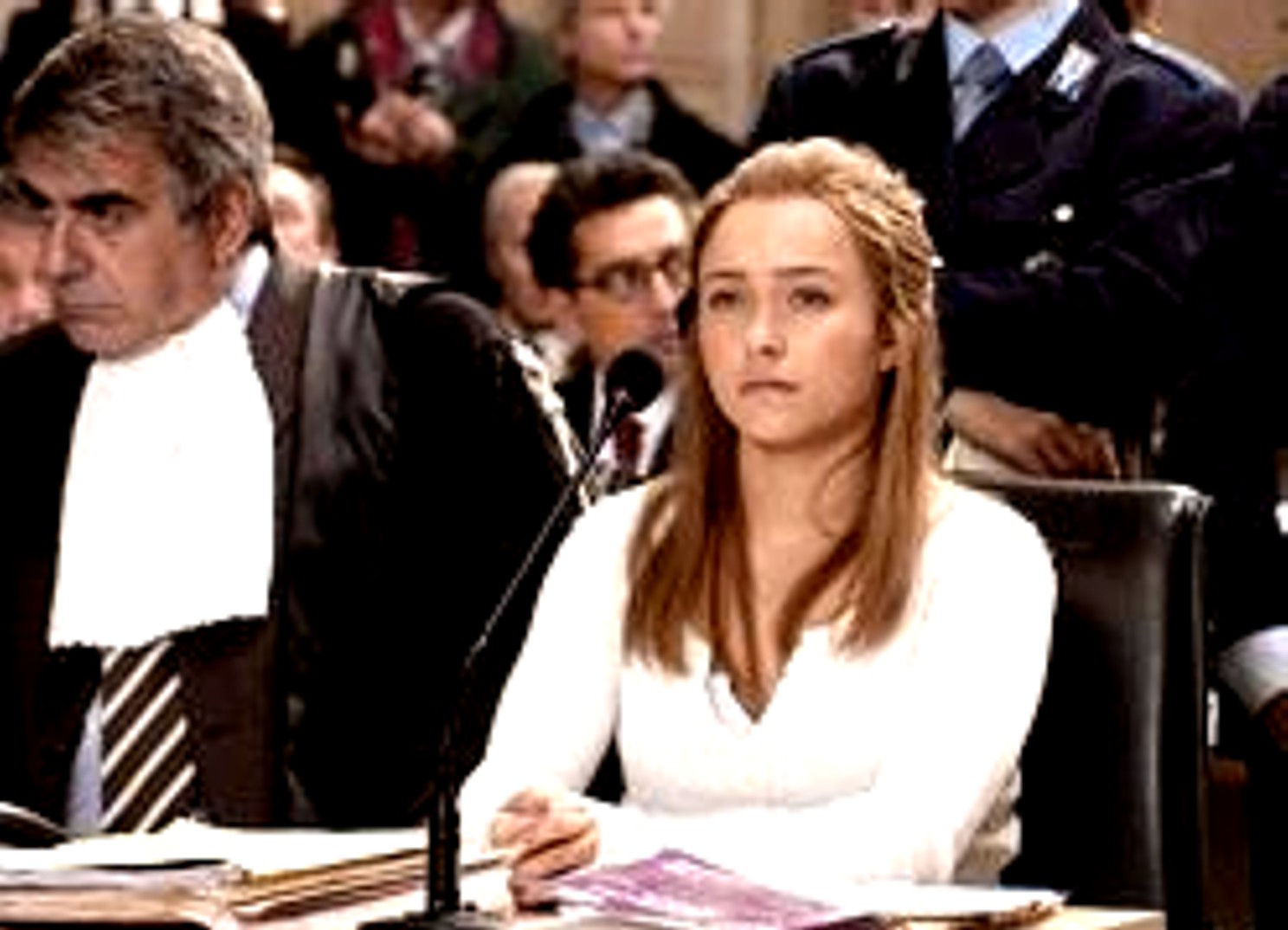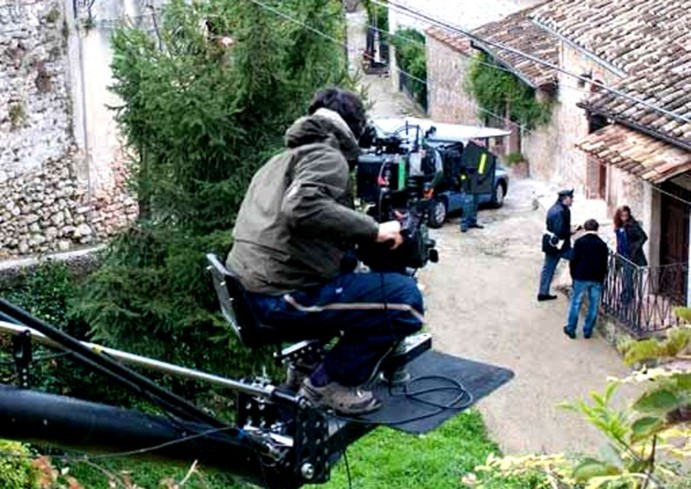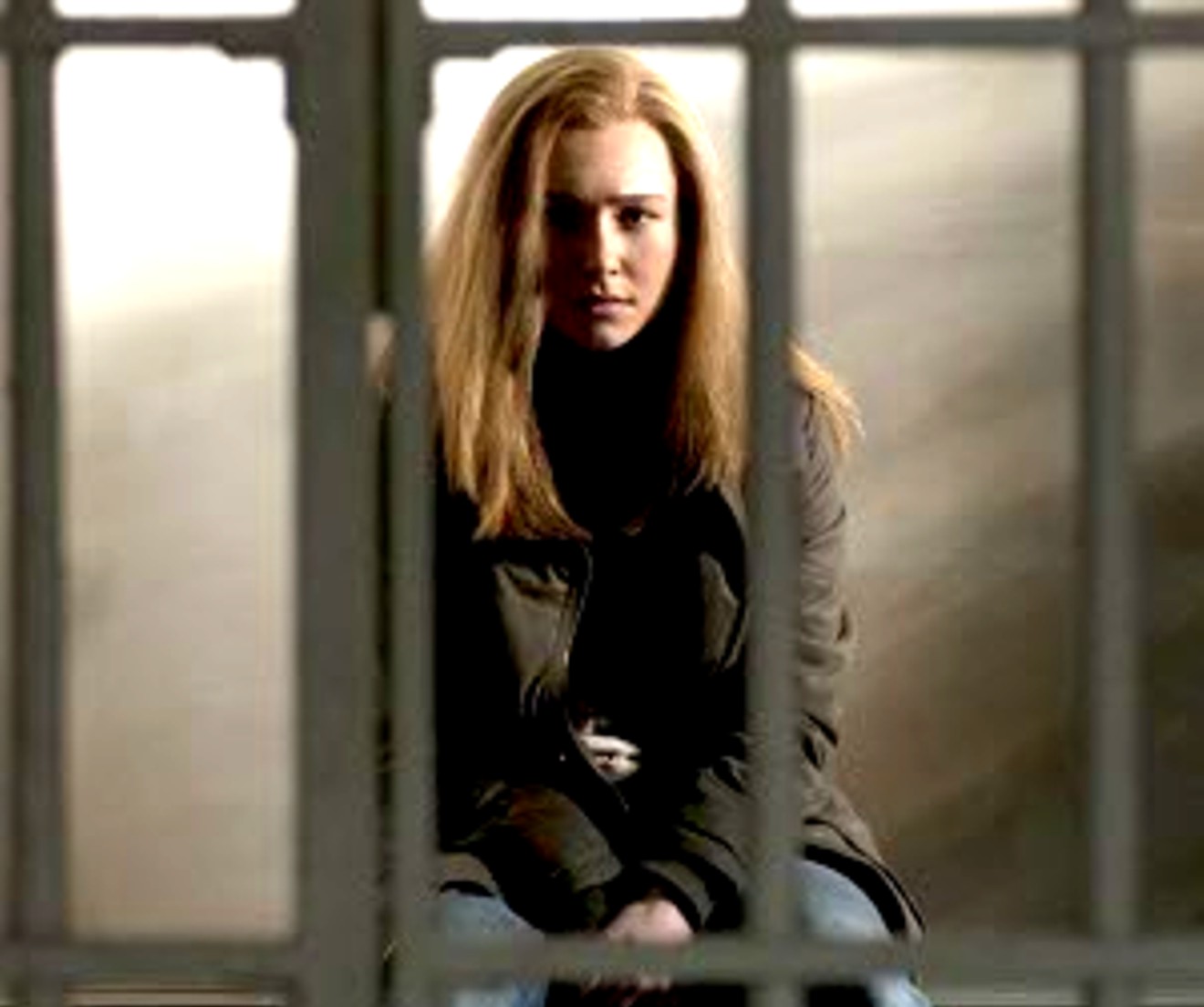
Category: Hoaxes Knox & team
Sunday, June 19, 2011
The Massei Sentencing Report For Knox And Sollecito: Part 2 Of A Summary In 4 Parts
Posted by Skeptical Bystander
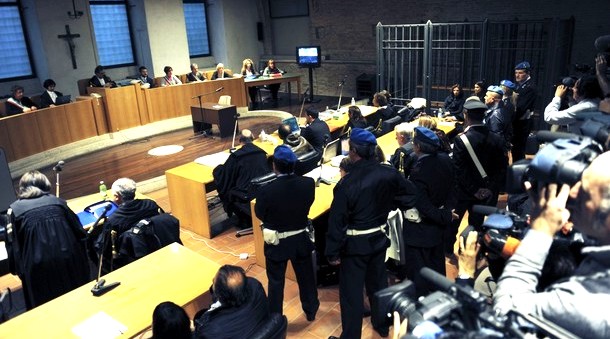
The full Massei Report can be found here. Continuing on with our summary:
4. Morning of November 2
Accounts of the events of the morning of 2 Nov do not agree. According to Knox’s statement, she and Sollecito slept until around 10-10:30 am.[67] After a while, she decided to go back to her house to take a shower and change her clothes, and to fetch a mop to clear up some water from a leaking pipe in Sollecito’s kitchen.[65] Her intention was that when she returned they would leave for a planned trip to the nearby town of Gubbio.[70]
When she arrived at her apartment, she was surprised to see that the front door was open. She entered the house, leaving the door open in case it had been deliberately left ajar by one of her flatmates, who might have gone out briefly, to get some cigarettes for example. She then went to her own room, undressed and went into the bathroom that she shared with Meredith. She took out her earrings and cleaned her ears - a regular necessity because the piercing in one ear had become infected. She noticed drops of blood in the sink, and thought this strange but continued to take a shower. Getting out, and not having remembered her towel, she decided to use the bath mat to shuffle into her own room. At that moment, she noticed the blood stain on the mat but thought it might be from some menstrual problem that hadn’t been cleaned up.[70]
Having returned the bathmat, she put her earrings back on, brushed her teeth, dressed in clean clothes and then went in the other bathroom (the one used by Romanelli and Mezzetti) and dried her hair with their hairdryer. She then noticed that there were feces in the toilet, which was strange as Romanelli and Mezzetti were very clean. She left her apartment, locking the front door, and went back to Sollecito’s, where they made breakfast and she told him what she had seen.[70]
In contrast to this account, forensic examination of Sollecito’s computer showed that it had been used for about half an hour from 5:32am to listen to music. After this, he turned on his mobile phone and, at 6:02 am, received an SMS message which had been sent to him by his father the previous evening when the phone was switched off. Phone records also confirmed a call made at 9:30am to Sollecito by his father. There was no mention of any of this activity in Amanda’s statement.[82]
According to the testimony of Marco Quintavalle, the owner of a small supermarket, he opened his shop at 7:45am on the morning of November 2 and almost immediately a young woman, whom he identified as Amanda Knox, went into the store department that had groceries, detergents and toilet paper on sale. He saw her leave again but did not know if she bought anything. Quintaville did not present this information to the police until some months after the crime and explained that, although he had previously been questioned about the morning after the murder, he had not been specifically asked about Knox. Another of the shop’s employees stated that she had not seen Knox in the store.[83-84]
The court highlighted the discrepancies between Knox’s account and the evidence of the computer and phone records and the testimony of the shop owner. It also doubted the credibility of Knox going back home to change her clothes, take a shower and fetch the mop to dry the floor. Since Knox and Sollecito had planned a trip to Gubbio that morning, she could well have brought the clothes with her that would be needed. It was also noted that Knox had already showered and washed her hair at Sollecito’s house, the previous evening: there was no obvious need for her to repeat those actions and, if there were such a need, there was no reason why she couldn’t do so at Sollecito’s. Fetching the mop to dry the floor was also deemed to be scarcely credible, considering that Sollecito employed a cleaner and, in any case, everything needed to clean up some water was already there.[85]
What is certain is that, around midday, Knox called Filomena Romanelli to say she had arrived at the apartment and had found the door open: she had taken a shower and it had seemed to her that there was some blood in the apartment. She said that she was going to Sollecito’s place but did not know the whereabouts of Meredith. Romanelli rang Knox back and Knox (now at Sollecito’s) told her that the window in Romanelli’s room was broken, everything was in a mess, and that she should come back home.[30]
Knox and Sollecito went back together to the house in Via della Pergola. According to their accounts, they looked in Romanelli’s room where there had apparently been a burglary, and checked the other rooms, but found nothing missing. They were worried that Meredith’s door to her room was locked and, when she was called, there was no answer. Sollecito made an attempt to force open Meredith’s door (described by the court as a ‘timid’ attempt, given that it was easily forced open later).[31] After that, they left the house, partly to look at the broken window from the outside.
Earlier that morning, two mobile phones had been discovered in the garden of a house located in Via Sperandio, a short distance from 7 Via della Pergola (the shortest route would be distance of about 5-7 minutes on foot, according to one witness).[25] The owner of the house had contacted the Communcations Police with regard to a telephoned bomb threat which she had received and then discovered the two phones. One of the phones was registered to Romanelli (although both were in fact Meredith’s phones - one given to her by Romanelli for use in italy).[26][30]
The Communications Police traced Romanelli’s address and arrived at the girls’ apartment some time between 12:30pm and 1pm. Outside the house, they found Amanda Knox and Raffaele Sollecito ““ who said that they were waiting for the carabinieri, whom they had called because they had been away for the night and had come back to find the entrance door open and then a window broken.[28]
Romanelli, her friend Paola Grande and their boyfriends, Marco Zaroli and Luca Altieri arrived around 1pm.[28] Romanelli made a quick check of her room, discovering that, although it was in a complete mess with the windowpane broken and clothes thrown around the floor, nothing was missing.[31] Nonetheless, she was concerned that the front door had been found open, bloodstains had been found in the small bathroom, and there was no news of Meredith. Furthermore, Meredith’s bedroom door was locked.[31]
The significance of this fact subsequently became a point of disagreement, with Knox saying that even when she went to the bathroom for a shower Meredith always locked the door to her room (the fact that she said this being confirmed by Zaroli and Altieri). Romanelli, on the other hand, said she was aware of only one occasion when the door had been locked and this was when Meredith had returned to England for a few days.[31]
The Massei report notes Knox’s apparent lack of concern at the locked door, both in the presence of the Communications Police and in her earlier telephone conversation with Romanelli. This was at odds with an email that Knox sent to her friends and family a few days after the murder (November 4, 2007) in which the locked door acquired a central importance and Knox described herself as “panicking” when she first discovered it. Massei concludes that panic at the locked door would be a logical reaction if Knox had been uninvolved in the murder, but according to Romanelli and the Communications Police, there was no such panic.
Knox and Sollecito, in fact remained in the living room, some distance away from Meredith’s room, while Romanelli and her friends were so concerned that they decided to force the door open. One of Romanelli’s friends broke down the door and the bloody body of Meredith Kercher was found.[32] The Communications Police sealed the area and called the Carabinieri, who arrived a short time later.[33]
5. Pathology: Injuries, time and cause of death and Conclusions
Massei observes that the injuries Meredith Kercher sustained were the subject of intense analysis and speculation in the courtroom, yet his summary and conclusions are clear and concise. Many of Meredith’s injuries appear to have been caused by the actions of restraining, whereas some were obviously inflicted by a knife or knives and showed great diversity in both dimensions and overall harmfulness. Massei found that one point was particularly significant: the knife wounds from the attack to Meredith’s neck came from both the right and the left sides.[371]
Massei believes Meredith’s injuries lie at the heart of the debate over the single attacker versus the multiple attacker scenarios. The hypothesis of a single attacker requires that the single attacker continually modify their actions, first by exercising a strong restraining pressure on her, producing significant bruising, and then for some reason switching to life threatening actions with a knife, thereby changing the very nature of the attack from that of subjugation to that of intimidation with a deadly weapon, and finally to extreme violence by striking first from the right penetrating to a depth of 4cm (1.5 inches) and then from the left to a depth of 8cm (3 inches) into the neck.[371]
Massei describes the first knife blow coming from the right by saying that it was apparently halted from going any deeper by hitting the jawbone. The Court considered that this blow was an effort to force Meredith to submit to an action against her will. The Court also considered that the penetrating knife wound from the left was preceded by the action of running the knife over the surface of the skin on the same part of Meredith’s neck, just a few centimeters below the eventual strike zone where the serious, deeper second wound was inflicted.[371]
What surprised Massei about Meredith’s wounds was that in spite of all the changes in approach during the attack she somehow remained in the same vulnerable position, leaving the same part of her neck fully exposed to an attacker. If this were a solo attacker then this person released a firm restraining grip on Meredith to somehow bring a knife into play, then striking her first from the right and then switching the knife-holding hand to somehow float a knife in an intimidating manner across her neck on the left, before finally stabbing her in that same location on the left with a final debilitating blow.[371-372]
Massei concludes that throughout the attack Meredith remained virtually motionless, and he cites the almost nonexistence of defensive wounds on other parts of her body in comparison to the number, distribution, and diversity of impressive bruises and wounds to her face and neck. Massei finds this disproportion to be a significant factor, particularly when considering Meredith’s physical and personality characteristics.[370,371]
Meredith’s physical build was described as being slim and strong; possessing a physique that would have permitted her to move with agility. In addition, Meredith was described as being athletic and one who practised football, karate, and boxing.[369] Therefore, the court found it unlikely that only one person performed the attack against her, and inevitable that several people had acted together against Meredith; a group who forcibly restrained Meredith in movement so that she could not defend herself in any way nor shield herself with her hands in order to avoid the repeated attacks to her neck.[371]
Meredith’s defensive wounds were found to be minimal and consisted of a 0.6cm (quarter inch) long superficial slice on the palm of her right hand showing only a trace of blood and another 0.6cm (quarter inch) slice on the second finger of her left hand, along with several highly superficial cuts to the fingertip of the index finger. Massei finds this remarkable considering that the normal and instantaneous human reaction to that first violent knife stab to the neck would have been to protect the area of attack, along with a strong desire to escape even if it meant receiving a blow to another part of the body. However, Meredith remained in the same standing position while continuously offering her exposed neck to the actions of the person(s) striking her, with the peculiar distinction of striking first from the right and then from the left. Massei believes that a scenario as such seemed inexplicable, unless one accepts the presence of more than one attacker who, as a group, forcibly restrained the athletic Meredith’s movements while intimidating and striking her from multiple angles.[369]
Massei also believes that evidence demonstrated Meredith was still dressed and awake when the attack began on her and that the violence against her could not have taken place as it did if Meredith were lying on her bed. Massei concludes that Meredith was sober and fully conscious since no traces indicating either the use of drugs or the abuse of alcohol were found; all of which, if present, might have contributed an inability to firmly resist an attack.[369]
Furthermore, Massei finds it impossible to imagine a scenario in which a single person could have removed the clothes that Meredith was wearing (shoes, pants and underwear) while inflicting the sexual violence revealed by the vaginal swab. Massei finds it highly unlikely that one person could have caused all of the resulting bruises and wounds cited above in addition to removing her sweatshirt, pulling up her shirt, and bending her bra hooks by force before finally tearing and cutting the bra. The actions on the bra alone, during which a small piece of material with hooks was cut off and thrown to the floor, were necessarily conducted from behind Meredith and required the attention of both hands of an attacker, and thus Meredith would have had her own hands free to attempt actions of self-defense.[370]
Massei concludes there was very little evidence of any defensive maneuvers on the part of Meredith, which to him was a strong indication that several attackers were present, each with a distribution of tasks and roles: either holding Meredith and preventing her from any significant defensive reaction, or actually performing the violent actions. Massei concludes that the rest of the body of evidence came in full support of such a scenario, recalling that a biological trace of Rudy was found on one of the cuffs of Meredith’s sweatshirt indicating a gripping in order to prevent any reaction. In drawing together all of the elements mentioned above, both circumstantial and forensic, Massei concludes that the diverse morphology of the injuries, their number, and their distribution mandated that the violence against Meredith was performed by multiple attackers.[370-371]
Summary of pathology findings
Massei describes the significant injuries discovered during the post-mortem examination and states that there were no noticeable injuries in the chest or abdomen areas, two areas of slight bruising on one elbow, small wounds on the hands indicative of a minimal defensive response, very slight bruising on the front of the left thigh, minor bruising on the front middle of the right leg, and a slight area of bruising just below the top of the head.[111-112]
Massei cites compelling evidence of recent sexual activity having the characteristics of non-cooperation on the part of the female participant. Non-spermatic biological material belonging to Rudy Guede was discovered during the course of a gynecological examination of the corpse. This, in conjunction with a distinct pattern of abrasions, was interpreted by the court as being strong evidence of sexual violence.[157-158]
The head and neck injuries were the most significant and included small spots inside the eyelids indicative of asphyxiation, a bruise to the cheek possibly caused by a knife point, bruising on the nostrils and trauma to the lips suggestive of silencing or suffocation efforts, biting injuries to the tongue, bruising and abrasions on the lower jaw indicative of a hard compression by hand, and neck swelling and hemorrhaging with pools of blood left inside the lungs as a result of two significant knife wounds.[111]
Dr. Lalli, the Perugia Coroner, who performed the autopsy on Meredith at the morgue of the Perugia Polyclinic, reported that the hyoid bone, located at the back of the tongue muscle had been “severed”.[145: Professor Torri quotes Dr. Lalli’s comment]
The most significant wounds Meredith sustained were inflicted by knife-stabs and thrusts occurring very quickly from the right and from the left, severing the right superior thyroid artery and the hyoid bone.[139] The largest of these was inflicted by a knife high on the left side of the neck near the jawbone which penetrated to a depth of 8cm (3 inches).[111]
Another significant knife wound, 4cm (1.5 inches) deep, was noted on the right side of the neck, above which were found superficial parallel scratches. The wound from the right crossed the path, inside the neck, of the wound from the left. The Court concluded that these knife wounds were made by single-bladed, pointed cutting tools and that Meredith’s injuries might be consistent with a virtually infinite number of instruments, provided they had a blade with only one sharpened edge that was not serrated.[111-113]
The Court held that it is self evident that should one conclude during forensic pathology investigations that a knife is not compatible with any of the wounds inflicted on the victim, it would be pointless to give that knife further consideration, including DNA testing.[166]
The experts and consultants who were examined during the course of the trial, taking into examination the various wounds present on the neck, did exclude the compatibility of Raffaele’s knife with the smaller stab wound inflicted on the right side of the neck, and the Court agreed. However, the Court did not agree with arguments that the knife confiscated from Raffaele’s flat was incompatible with the deep wound on the left. The Court concurred with expert testimony proclaiming that the knife presented by the prosecution as the murder weapon, with the DNA of both Meredith and Amanda on it (ie the “double DNA knife”), is clearly compatible with the large fatal neck wound.[169-173]
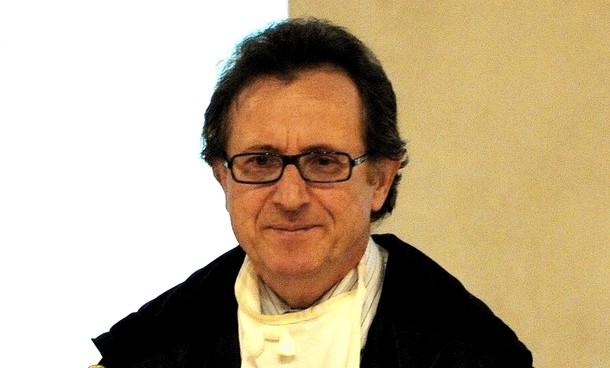
Cause of death
The Court found that the death of Meredith Kercher was asphyxia caused by the neck-wound which severed both the hyoid bone and the right superior thyroid artery. The severing of the hyoid bone opened Meredith’s airway directly through the skin to the atmosphere, and the severed right superior thyroid artery was the main source of the blood which asphyxiated her when she then inhaled blood directly through her severed airway down into her lungs.[162]
Time of death
In order to preserve the crime scene, a thorough examination of the corpse was not performed until approximately 11 hours after the body was discovered. Relying upon the criterion of body temperature and the influences of various other factors such as blood loss, the corpse being covered with a duvet, and other environmental conditions the time of death was initially placed approximately between 8:00 pm November 1, 2007 and 04:00 am November 2, 2007. An intermediate value for such a time range is considered of value, and the actual time of death was suggested by the coroner as being approximately 11.00 pm on November 1, 2007. The combined criteria of temperature, hypostatic stains, and rigor mortis all supported this range for the time of death, but for a variety of reasons were unable to accurately define a more narrow time of death range.[113-116]
Massei notes that the state of digestion of Meredith’s stomach contents provided significant additional information towards establishing a more accurate estimate for the time of death. Meredith’s stomach contents included apple, cheese, and floury fragments of the apple crumble she ate while visiting friends, which had not yet entered into her the small intestine. In addition, a piece of mushroom was also found in Meredith’s esophagus. This could not have been consumed during the meal with friends, which did not include mushrooms, since it was in a different less digested state.[115, 178-179]
Testimony during the trial established that an emptying of the stomach into the small intestine under typical conditions starts between two and four hours after the start of a meal. A complicating factor is that Meredith apparently ate additional food at home after her earlier meal which, according to statements made by the British friends of Meredith, occurred sometime between 6 pm and 8 pm. Nevertheless, it becomes possible to propose a time of death as being 3 to 4 hours beyond the time frame of the initial eating event: therefore, this could reasonably range between 9pm (around the time she arrived home) and midnight of November 1, 2007. This timeframe remains consistent with all other indicators. It is important to note that the beginning of the attack would have been a moment of tremendous stress for Meredith that may have arrested her digestive process. However, Massei notes that this, like many other variables concerning the behavior of the digestive tract, remains in the realm of speculation.[178-179]
The various consultants and experts heard in court regarding the time of death all emphasized the difficulty of establishing a precise time. Regarding time of death, there can be no doubt that Massei relied upon the evaluations of a variety of evidentiary sources, including the consideration that Meredith would not have been able to make any vocalizations following the final fatal stab wound to her neck, which lends importance to witness statements regarding when they may have heard a scream on the night of the murder. However, the Court concluded that testimony regarding the pathology alone made it possible to suggest that the time of death that was, in fact, within a range of tens-of-minutes either before or after 10:50 pm November 1, 2007.[131]
6. Forensic investigation
The forensic evidence included the analysis of DNA in various samples taken, of footprints revealed by Luminol, and of foot prints and shoe prints.
Meredith Kercher
The fatal wound was swabbed in order to obtain the profile of her DNA for comparison with other samples. [190] One of two swabs of her vagina produced genetic material, the DNA of the Y chromosome of Rudy Guede. [189] Samples taken from under her fingernails yielded only her own DNA. The court noted that her finger nails were very short and probably would not inflict significant scratches on an attacker. [190]
Rudy Guede’s Y chromosome was also found mixed with Meredith’s blood on Meredith’s handbag and on the left cuff of her sweatshirt.[192]
The Small Bathroom
Blood was found in seven locations in the small bathroom that Knox shared with Meredith. [192]
“¢ The Door Frame: blood was found on the right, inside door frame containing Meredith’s DNA. [192]
“¢ The Light Switch Plate: Meredith’s blood was also found on the light switch. [192]
“¢ The Sink: Blood was found in two places. There was dried blood near the faucet that had the DNA of Knox. [192] A streak from the left part of the sink toward the drain containing Meredith’s blood mixed with DNA of Knox.[192]
“¢ The Bidet: Meredith’s blood was found mixed with the DNA of Knox.[192]
“¢ The Toilet Lid: Meredith’s blood.[192]
“¢ Q-tip Box: Meredith’s blood mixed with DNA of Knox.[192]
“¢ The Bathmat: Three samples taken from the bathmat yielded Meredith’s blood.[192] The bloodstains on the bathmat were studied and compared with footprints taken of the right foot from Knox, Sollecito, and Guede, and found to be that of Sollecito. [351-355]
The Large Bathroom
Toilet paper and faeces were found in the toilet. Testing the toilet paper found the DNA of Rudy Guede.[192]
Traces Revealed by Luminol
Various surfaces were sprayed with Luminol, which fluoresces brightly when applied to blood. The fluorescence was then swabbed and tested for DNA. Nine traces were found; two were Meredith’s, three were Knox, and two were mixed DNA of Meredith and Knox.[281-286]
“¢ Romanelli’s Bedroom: One sample of Meredith, and one of Meredith’s blood mixed with DNA of Knox.[282]
“¢ Hallway: Three footprints matching, based on measurements, Knox’ right foot were found, two facing the exit, and one oriented toward the doorway of Meredith’s room.[247]
“¢ Knox’ Bedroom: Footprint of Amanda Knox’ right foot, also identified by measurements.[247]
Shoeprints
Shoeprints made in Meredith’s blood and visible to the naked eye led from Meredith’s bedroom to the exit, becoming fainter toward the exit. [193] These were determined to be incompatible with Sollecito’s shoe size 9, and to be compatible with a Nike Outbreak 2, size 11.[334-336]
Although the shoes were never found, a box for Nike Outbreak 2, size 11 was found in Guede’s apartment.[334]
A left shoe print was found on Meredith’s pillow, estimated to be between size 36 and 38.[342]
Knox wears a size 37.[343] A defense expert made a comparison of the sole pattern with Guede’s right shoe, and argued that the print could have been made by him. The court noted the conflicting theories without expressing a specific opinion,[343-344] and noted that Knox seemed to have been moving about the scene in her bare feet.[344]
Other Evidence
“¢ A small trail of drops of Meredith’s blood from the small bathroom to the kitchen/living room.[193]
“¢ A cigarette butt found in the kitchen had mixed DNA of Sollecito and Knox.[197]
“¢ A jack knife belonging to Sollecito was found to have the DNA of Sollecito and Knox, but no blood.[195]
The Court’s Analysis:
The defense did not contest the mixed DNA test results, but instead argued that they were irrelevant: that mixed DNA would be expected since Meredith and Knox lived in the same house and shared the small bathroom. [378] They suggested that Knox’s DNA could be exfoliated skin cells. Dr. Stefanoni (for the prosecution) testified that exfoliated skin cells are keratinized and contain no DNA. [202]
The court concluded that Knox’ DNA became mixed with Meredith’s blood from vigorous scrubbing of the hands and feet, and that this is how the mixed DNA sampled came to be found in the sink and the bidet.[279]
DNA testing cannot, by itself, determine when biological material has been deposited, or in the case of mixed DNA, which was deposited first or whether it was simultaneous. [211] However, the court noted that Knox told the court in her answer to questioning that the bathroom was clean when she left the house on the afternoon of November 1.[278]
The court concluded that Meredith’s killers had gotten blood on their hands and elsewhere on their bodies, and that they needed to clean off the blood. Accordingly, they tracked blood on their feet to the small bathroom, where Meredith’s blood was transferred to the doorframe and light switch plate when they turned the light on in order to use the bathroom.[279] Sollecito tracked Meredith’s blood into the bathroom, leaving a partial print of his right foot in blood.[379]
Knox was not wounded.[280] The trace of her blood on the tap was different in appearance from the mixed DNA samples, and was explained by her as having come from her own ear having been pierced. [280] The mixed trace in the sink and the bidet appeared to have been diluted with water, constituting a single trace placed there by Knox when she was cleaning Meredith’s blood from her hands and feet.[378]
The defense experts did not specifically attack the accuracy of the findings on the trace evidence revealed by Luminol.[285] Dr. Gino noted that a generic test for blood was negative on the sample, and that the DNA test was low copy number. She also noted that substances other than blood can cause Luminol to fluoresce.[282]
The court observed that there was an abundant quantity of Meredith’s blood on the floor of the bedroom to be tracked around the house.[279] The fact that DNA testing revealed the presence of genetic material in the samples indicates the presence of biological material that reacts with Luminol. The court said that attributing the fluorescence to fruit juice, rust, bleach, vegetables, etc. could not explain the presence of reactive trace in so many parts of the house, whereas the walking in blood and subsequent cleanup easily accounts for the findings.[283-285]
The defense’s “low copy number remark” was rejected because Dr. Stefanoni had testified that the sample had been processed according to standards and procedures necessary for international quality certification, and noted that the certification was granted by the international certifying body in 2009; the quality certificate was an acknowledgement of what already existed, and had already been done.[285] Further, the court noted that the criticisms of Dr. Gino and Dr. Tagliabracci were hypothetical, and all concerned specific findings and a small portion of the specimens.[285]
The footprint on the bathmat was partial, missing the heel. [339] Based on the dimensions of the big toe, the plantar arch, and the shape and location of various “bumps”, Inspectors Rinaldi and Boemia concluded that the print was made in Meredith’s blood by Sollecito’s right foot, that it was consistent with Sollecito’s wider foot and inconsistent with Guede’s longer, narrower foot, and well as being inconsistent with Knox.[339-342]
The measurements from the bathmat: big toe”“33mm wide, 39mm long. Metatarsus”“99mm wide, 55mm long. [339]
Footprints taken with printer’s ink resulted: Big Toe—Sollecito: 30mm wide, 37mm long. [339] Guede: 23mm wide, 43mm long. Knox: 22mm wide, 41.8mm long.[339] Metatarsus”“Sollecito: 99mm wide[339]
Rinaldi and Boemia used the so-called L.M. Robbins grid, which is marked in centimeters, lining the vertical axis with right-hand outline of the foot, and the horizontal axis with the tip of the big toe. [340] By comparing the samples with the bathmat, they concluded that the shape of Guede’s plantar arch and the alignment of his “bumps” could not be reconciled with the print on the bathmat, whereas Sollecito’s bumps align consistently between his sample and the bathmat. [340-341] The primary distinctions between Guede’s right foot and Sollecito’s are: the width of the big toe, the shape of the metatarsus, differences in the plantar arch, and the shape of the left side of the foot.[341]
Professor Vinci, Sollecito’s expert attempted to show that the foot print was actually that of Guede. He argued that the morphology of Sollecito’s foot was such that his second toe made no contact with the paper, but that a portion of the mark on the right side of the big toe print on the bathmat is actually from the second toe. He thus measured the big toe print as being 24.8 mm wide.[352]
The court rejected this theory. It noted that the photograph appeared to show the opposite of what was claimed, i.e., it showed the blood had been deposited as a single unit on a decorative flourish of the mat. Moreover, the court noted that, by comparison, Guede’s foot is generally longer and more tapered, and that the second toe print falls quite far from the big. [354] Finally, the court discounted the idea that Guede had ever been in his bare feet that evening. The visible shoe prints clearly showed that he walked directly from Meredith’s room, down the hallway, and out the door.[379]
The Massei Sentencing Report For Knox And Sollecito: Part 4 Of A Summary In 4 Parts
Posted by Skeptical Bystander
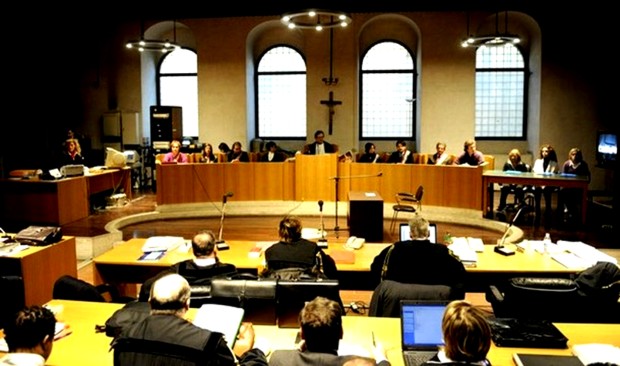
The full Massei Report can be found here. Continuing on with our summary:
9. Conclusions reached by the court
The court concluded that Amanda Knox and Raffaele Sollecito had colluded with the main protagonist, Rudy Guede, in murdering Meredith Kercher and that this was in the context of a sexual assault.[390-393]
The evidence that Guede was involved in the murder included his bloody handprint found on a pillow in Meredith’s room, and his DNA found on a vaginal swab taken from Meredith, as well as on the cuff of Meredith’s sweatshirt and on a strap of her bra and on her purse. Further biological traces of Guede were found on the toilet paper in the larger bathroom. His bloody footprints were found in the corridor leading out from Meredith’s room to the front door of the apartment. All this evidence pointed to Guede having been in the apartment, crossing the living room to the larger bathroom (where he used but did not flush the toilet), passing back through the living room and the corridor to Meredith’s room, where he committed the murder, then exiting directly along the corridor and through the front door.[43-44]
The court next considered whether Guede had entered the apartment through the broken window in Romanelli’s room.[45] The defense had argued that Guede had previously been found uninvited inside a Milan nursery school and had been in possession of items stolen from a Perugia law office which had been burgled by someone who broke a window with a rock. He had also been identified as the person who had broken into a house and threatened the occupant with a knife. The court noted this evidence but also highlighted some marked differences from the current case, and also the fact that there was no direct evidence that linked Guede to the law office burglary. In addition, the court made a detailed analysis of the evidence of the ‘break-in’ and concluded from many pieces of evidence (see section 8) that the ‘break-in’ had been staged and that no-one had entered the house through the broken window. In fact, the conclusion drawn by the court from this staging was that it had been done in order to throw suspicion onto a supposed intruder who did not have a key to the front door.[46-55]
The court next considered whether Guede might himself have staged the break-in, which might have happened if Meredith had let him in through the front door and he intended to throw suspicion onto a supposed burglar. The court rejected this hypothesis: if Guede was alone in the apartment, following the murder, it is improbable that he would have stayed longer than necessary, faking a break-in, when the other occupants, who would recognise him, might return at any moment. Further doubt is cast on this scenario by the fact that some aspects of the ‘break-in’ are superficially similar to other crimes associated with Guede, so might lead investigators directly to him. Finally, the court doubted that Meredith, alone in the apartment, would have let Guede, whom she barely knew, in through the front door, let alone waited in her own bedroom while he used the bathroom.
The conclusion of the court was that Guede was let into the apartment by somebody, other than Meredith, who had a key to the door and that the ‘break in’ was likewise staged by someone who had a door key. Laura Mezzetti was away from Perugia on the night of the murder and Filomena Romanelli was staying elsewhere, at a birthday party. This left Amanda Knox who had a key to the front door and lacked an alibi for the time of the murder. She, according to the court, was the only person who could have let Guede into the apartment and who also would have a motive for staging the ‘break-in’ to simulate the forced entry of an intruder.[56-58]
The court noted the ‘intense’ relationship between Knox and Sollecito, and the fact that they were both using drugs.[365] After Patrick Lumumba sent Knox a text, shortly after 8 pm on November 1, 2007, telling her that there was no need for her to go to work that evening, the pair of them were free of any commitment that evening. By 9:15pm they had eaten dinner and washed up (as witnessed by Sollecito’s father’s earlier phone call), turned off their mobile phones and made no further use of Sollecito’s computer. The court’s conclusion was that this point, they both left Sollecito’s apartment and were seen by the witness Curatolo, several times, around the Piazza Grimana.[359]
Guede already knew Knox and was attracted to her. The court believed that around 11pm, on the night of the murder, Knox, accompanied by Sollecito, let Guede into her apartment, possibly having first met him in the nearby square.[361] The reason for Guede’s visit to the apartment could not be known for certain: perhaps he was going to spend the night there as had happened on another occasion, although in the downstairs apartment; perhaps to hang out with Amanda and Raffaele for a while and to use the bathroom; maybe he had come to look for his friends in the downstairs apartment, and finding them absent, called on the upstairs apartment.[363] What is certain is that Guede used the toilet in the larger bathroom.[364]
Meredith had arrived home, alone, earlier in the evening and was most likely reading or studying in her own bedroom. The court found it probable that, having used the bathroom, Guede went into Meredith’s room, intent on making sexual advances, which were rebuffed. It was probably at this point that Knox and Sollecito joined Guede.[365-366]
The court concluded from the presence of Guede’s DNA in her body, that Meredith’s attack involved a sexual assault: the evidence that it was not consensual sex was deduced from other specific injuries as well as the obvious violence. Based on factors such as Meredith’s strength and physical fitness, and the way she had been undressed, they believed that she was the victim of multiple attackers.[369-372]
Based on the forensic evidence, the court believed a sequence of events in which Meredith refused to accept an invitation of an erotic-sexual nature and was then grasped by the neck by her assailants, for the purpose of intimidating her. When this intimidation was unsuccessful, it led to an escalation of violence, which involved the small stab wound to the neck.[164]
It is likely that it was at this point that Meredith’s trousers and underwear were removed by her assailants and that she was sexually assaulted. Her top was lifted up and rolled up towards her neck and there was an attempt to unfasten her bra which, despite her resistance, was eventually cut off. A pillow was placed under Meredith to allow further sexual activity: from Guede’s bloody hand print on the pillow, it was deduced that Meredith was already bleeding at this point. Part of the bra, including the clasp which bore Sollecito’s DNA, was found under the pillow, which indicates that this was cut off before the pillow was placed.[164-165]
It was, the court believed, around this time that Meredith screamed loudly, as confirmed by the evidence of Nara Capezzali and Antonella Monacchia, which placed the time around 23:30 pm. The response of the assailants was the compression of the upper airways, by pressing a hand over Meredith’s mouth and nose, and then inflicting the deep knife wound to the right side of the neck. Their conclusion was that death occurred a few minutes later, and was caused by asphyxia resulting from the major neck wound from which there was bleeding into the airways, impeding respiratory activity. This was exacerbated by the severing of the hyoid bone ““ also attributed to the knife wounds.[165]
In the court’s opinion, the initial attempt had not been to kill Meredith, but there was “a crescendo of violence” in which the assailants simply accepted the risk of death, constructively transforming their initial non-homicidal intent into a pro-homicidal intent characterised by reckless malice.[171]
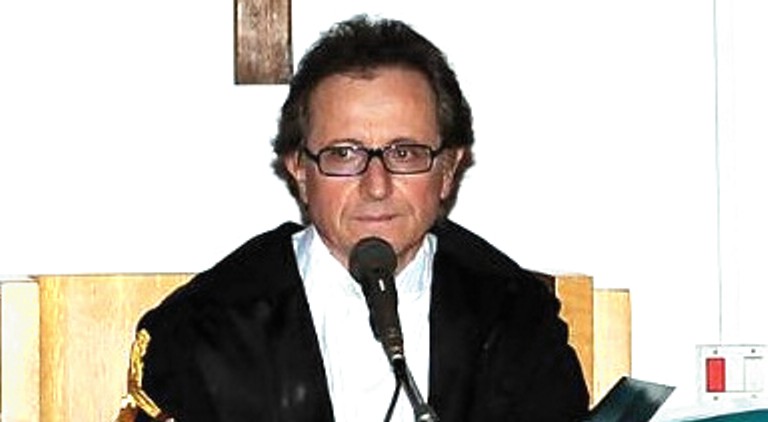
Regarding the murder weapon, the court found it difficult to accept that the wounds of various sizes were all made by the same assailant and the same knife. Their conclusion was that the smaller wounds were made with a pocket knife that has never been identified, but the largest (and fatal) wound was made with the knife which was subsequently recovered from a drawer in Sollecto’s house and which bore traces of Meredith’s DNA on its blade and Knox’s on the handle (the “double DNA knife” discussed in section 7.1).
The court believed that, following the murder, the murderers went into the smaller bathroom to wash off some of the blood as witnessed by the traces of blood found there. They rejected the possibility that these were older traces, left from some previous incident, as Knox had testified that that bathroom was clean when she left on the afternoon of November 1.[278] In the process of cleaning themselves, the murderers must have touched the door and the light switch, leaving a dribble of blood on the former and stains on the latter.[281] The bloody footprint on the bathmat (which matched the size of Sollecito’s foot), indicates that whoever went into this bathroom was barefoot, and must also have been barefoot in Meredith’s room.[279] While in the bathroom, it was deemed likely that the murderers scrubbed their hands, thus leaving mixed traces of Meredith’s blood and their own DNA in the sink and the bidet.[279] The court noted that the traces found in the small bathroom not only tested positive for blood, but also included a mixture of Knox’s and Meredith’s DNA. They concluded it was Knox who, on the night of the murder, had washed off Meredith’s blood in the sink and in the bidet.[280]
The court considered the traces shown up by Luminol tests in Romanelli’s room, Knox’s room and the corridor. Luminol tests positive for blood but can give false positive readings for other substances, including fruit juice, rust and bleach. Other tests for blood were applied to the same traces and proved negative, but were noted to be less sensitive than Luminol. The court considered the alternative interpretations of the Luminol results: it found it improbable that the traces were caused by such things as fruit juice or rust - particularly as there was no explanation for why such substances would be in all three locations. The possibility of bleach having been spread through the three rooms was more feasible, but in that case, the court wondered why it would not appear elsewhere in the apartment. Also there was no evidence (smell for example) that bleach had been used.
Furthermore, the traces contained biological material, although it could not be proved to be blood. Considering all the possibilities, and the fact that there were copious amounts of blood at the murder scene, the court believed that the Luminol traces were indeed blood. They noted that the traces tested positive for Knox’s DNA and, in two cases, also included Meredith’s DNA. Their conclusion was that Knox had washed her bare feet in the bathroom, but some residue of Meredith’s blood had remained on the soles, and she had then walked into her own room, into Romanelli’s room and passed through the corridor, leaving the traces which were discovered.[281-286]
The conclusion of the court was that Guede had left immediately, but Sollecito had then brought in a big stone from the surrounding area and he and Knox had broken the window in Romanelli’s room with it and attempted to fake a break-in. They had gone back into Meredith’s room, covered her body with a duvet, then locked her door.[381] The court believed that the murderers took Meredith’s mobile phones, left the apartment and dumped the phones in a nearby garden. This must have happened before about half past midnight, as can be deduced by the phone records.[383] Knox and Sollecito returned to his apartment where he made a very brief (4 second) use of his computer at about 1am.
Contrary to the statements of Knox and Sollecito, his computer was in use for half an hour from about 5:30am the following morning, and he turned on his mobile phone at about 6am. The court believed that Knox and Sollecito returned to the murder scene that morning, with Knox perhaps having bought cleaning materials from Quintavalle’s shop at about 07:45.[384] There was evidence that cleaning had taken place: for instance the bath mat marked with a bloody footprint could only have been reached by taking steps that should also have left other footprints. None were found, so the logical conclusion is that they had been cleaned up. Even the drip of blood left on the internal edge of the bathroom door was said to seem like the remainder of a much larger trace.[384]
In conclusion, the court stated that all of the elements put together, and considered singularly, create a comprehensive and complete framework without gaps or incongruities and lead to the inevitable and directly consequential attribution of the crimes to both the accused.[388]
Wednesday, June 08, 2011
It Seems Mignini Demonizer + Knox Fawner Judy Bachrach Learned Nothing In The Past Year
Posted by The Machine
Bachrach again. She never learns. Here is my post of a year ago showing how she misleads
Hmmm. Isn’t Mr Mignini already suing people for hurtful claims about him not unlike those made very dogmatically in the video above?And the similar hurtful claims made very dogmatically in the two videos down below here? Certainly Mr Mignini would seem to have what you might call a not-unstrong case.
- First, the numbers of police, investigators and judges hoodwinked would have to have been truly huge. This case has a VAST cast of characters in Italy seeking true justice for Meredith - a jury, for example, and twenty judges by present count, and a nationally known and respected co-prosecutor.
- And second, nothing in the judges’ sentencing report, which PMF and TJMK are in the final laps of translating into English, appears to back up her claims. Judge Micheli’s report a year ago, which explained Guede’s conviction and the reasons for sending Knox and Sollecito to trial, was already an almost unassailably tough document. And the report by Judges Giancarlo Massei and Beatrice Cristiani? It is even tougher.
Judy Bachrach has popped up repeatedly to straighten out us lesser beings on the case. For her, it appears to be almost a small industry. She is perhaps the most vehement and impervious of all the proponents of the notion that Amanda Knox and Raffaele Sollecito are somehow being railroaded, by a corrupt prosecutor, Mr Mignini, and an incompetent legal system.
Wouldn’t you expect Judy Bachrach, as a professional journalist and a contributing editor to Vanity Fair, to research her articles more meticulously? And to verify every single one of her claimed facts? In the same way that the Italy-based reporters we like to quote have incessantly managed to do - really quite brilliantly?
We have been analyzing Judy Bachrach’s many, many articles and TV commentaries about the case, and they all seem to point to the following conclusions.
- That she hasn’t ever read the Micheli report and doesn’t seem to have actually ever mentioned it.
- That she hasn’t had full access to the prosecution’s 10,000-plus pages file of evidence, and maybe she has had no access at all.
- That she didn’t attend the key court sessions in which highly incriminating forensic and circumstantial evidence was presented.
- That she hasn’t absorbed the numerous factual newspaper and magazine reports about the key forensic and circumstantial evidence.
- That she seems to rely either a lot or totally on sources with vested interests who feed her wrong theories and false information.
- And that she comes across to us as the reporter most often showing on US media outlets the most complete ignorance of the case.
Quite a track record. We wonder if she is really very proud of it. She seems to sound so. Now to examine the details of some of her small jungle of wrong claims.
False Claim #1
Judy Bachrach made the following claims in an article entitled “Perugia’s Prime Suspect” for for Vanity Fair.
Rudy Guede’s DNA would be found all over her dead body the next day….“His DNA was found not only all over the British girl’s body but also in his bloody fingerprint staining one of her cushions and on the straps of the bra she wore the night of her death.
Judy Bachrach’s claims that Rudy Guede’s DNA was all over Meredith’s body have long been demonstrably false. According to the Micheli report here quickly translated here there was only ONE instance of Rudy Guede’s DNA on Meredith.
Where exactly did Judy Bachrach get that false information from? It clearly wasn’t from the DNA results from the tests carried out by Dr. Stefanoni and her team, or any official court documents, or the Micheli report.
And why exactly did she propagate it? Was she perhaps deliberately trying to exaggerate the evidence against Rudy Guede? Whilst playing down or completely ignoring the forensic and circumstantial evidence against Knox and Sollecito?
False Claim #2
In the same Vanity Fair article, Judy Bachrach makes the claim that “Amanda had tried three times to reach Meredith by cell phone, without success.”
If Judy Bachrach had examined the mobile phone records which are part of the prosecution’s 10,000 page report, as the court did and as we have done, she might have concluded otherwise - that Amanda Knox never ever made even one genuine attempt to contact Meredith.
Two of Knox’s phone calls lasted only 3 seconds and 4 seconds.
Judy Bachrach would have also realised that Knox’s claim that Meredith’s Italian phone “just kept ringing, no answer” was in fact a lie. And that Knox’s e-mail version of events at the house on 2 November is totally contradicted by what is in those mobile phone records.
Our poster Finn MacCool rather brilliantly drew attention a year ago now in this post here to how very, very incriminating those phone records are. (They also seem to incriminate Amanda Knox’s mother. Why doesn’t a good reporter actually ask her about this?)
Judge Massei and Judge Cristiani certainly don’t believe that Knox made a genuine attempt to contact Meredith. And they provide a very detailed explanation of why they don’t, in the sentencing report we are now translating.
And as you will soon see in that report, they also pull totally apart Knox’s email version of the events on 2 November to her friends and family in Seattle.
False Claim #3
Judy Bachrach has claimed that the bra clasp in Meredith’s bedroom was “discovered” only in January 2008.
But to complicate matters, a forensics team took a second look around the House of Horrors in January; this time they discovered a clasp that had been cut off the same bra. On that clasp they found Raffaele’s DNA.
House of Horrors? A callous way to refer to the sad place where a remarkable girl with a grieving family and many grieving friends was tortured and then deliberately left to die.
And in actual fact, Dr. Stefanoni was fully aware that the bra clasp was missing from the time she reviewed in the Rome labs the evidence collected from the crime scene - early in November. The clasp couldn’t be collected until the defense experts had agreed upon a date.
There was no other cause to the delay, and the bar clasp was never simply “discovered” at the second evidence visit in January. The forensic team went there specifically to get it. And it was actually recovered on 18 December 2007.
False Claim #4
Perhaps the reason why Judy Bachrach gets so many of the basic facts like those above wrong is that she seems to rely very heavily on sources who feed her false information. One example:
But three legal sources in Perugia (two unfriendly to Amanda) tell me the injuries sustained by Meredith were inconsistent with the blade of that knife.
All of Judy Bachrach’s “three legal sources” provided her with wrong facts.
The double DNA knife found in Sollecito’s apartment is fully compatible with the deep puncture wound on Meredith’s neck. This has been widely reported by a number of journalists in the British and American media. For example “According to multiple witnesses for the defense, the knife is compatible with at least one of the three wounds on Kercher’s neck, but it was likely too large for the other two.” (Barbie Nadeau in Newsweek).
The sentencing report of Judges Giancarlo Massei and Beatrice Cristiani also now confirms that the knife is absolutely compatible with the large wound on Meredith’s neck.
False Claim #5
Judy Bachrach claims that when Knox and Sollecito changed their versions of events they did so because things got rough.
Simultaneously, in a separate room, Raffaele, too, was questioned by police. Like Amanda’s, his version of events seemed to change whenever things got rough.
Raffaele Sollecito actually changed his version of events most dramatically on 5 November 2007 when he was confronted with the telephone records that proved that he and Knox had lied. It was then that he in effect threw Knox under the bus, and he has never really backed her versions of events on the night fully ever since.
And Amanda Knox in turn changed her version of events most dramatically when she was informed that Sollecito had admitted that they had both lied, that he was wrong to go along with her version, and that he was in effect no longer providing her with any alibi.
Knox and Sollecito’s multiple conflicting alibis did NOT happen because “things got rough”. They actually happened because Sollecito and Knox were both repeatedly caught lying. And they changed their stories periodically merely to fit the new information as it became known - and at pretty well no time after they were first caught out in their lies did the stories of the two ever match. .
By the way, wait for something of a bombshell. Judges Giancarlo Massei and Beatrice Cristiani in their sentencing report expose more lies and contradictions by Knox and Sollecito which haven’t as yet been reported in any of the English-language the media.
False Claim #6
Judy Bachrach wrote an article about the case for the website Women on the Web headlined Amanda Knox’s Abusive Prosecutor.. (Hmmm. Smart title.)
Amanda was also told if she didn’t confess she would get the maximum ““ 30 years in prison. And ““ oh yes ““ at a time when, having just arrived in Italy, she spoke pitifully little Italian, she wasn’t provided with a translator.
Judy Bachrach clearly wasn’t in the courtroom when Amanda Knox’s interpreter, Dr. Anna Donnino, gave her evidence as to all the work she did on the night of the interrogations. And Judy Bachrach clearly hasn’t read the numerous articles that actually describe the interpreter’s testimony.
False Claim #7
Judy Bachrach claims that an Italian reporter was thrown into prison for being critical of Mignini. She is clearly referring to Mario Spezi.
Mignini is no special friend to journalists. One Italian reporter who especially upset the prosecutor a while back was thrown into prison “” in isolation. An American journalist who was that reporter’s friend was interrogated so harshly that, fearing incarceration himself, he hopped the next plane back to the United States, where he started a campaign (ultimately successful) to free his friend. Their crime? They were critical of Mignini.
Spezi is currently on trial for disrupting the investigation into the Narducci case. He has NOT been charged with criticising Mr Mignini.
Judy Bachrach has made a number of television appearances on CNN and other networks in which she was scathing towards Mr Mignini and the Italian legal system. As with her articles, Judy Bachrach makes many wild and inaccurate claims.
False Claim #8
She incorrectly asserts that the defence teams weren’t allowed to produce evidence of their own DNA experts - despite the fact that the Knox and Sollecito defenses each had large teams of DNA experts testify. From the videos in this post:
The defence wasn’t even allowed to produce evidence of their own DNA experts.
Gino Professor, Carlo Torre and Walter Patumi were some of the DNA experts who testified at the trial on behalf of Amanda Knox. Professor Vinci, Adriano Tagliabracci and Francesco Introna were some of the DNA experts who defended Raffaele Sollecito.
False Claim #9
Judy Bachrach has repeatedly claimed (you can see her do so in these videos) that Amanda Knox was kept in prison for two years before her trial.
They kept her in jail for two years even before trial [although] there isn’t an ounce of real hard evidence against her” And “It was decided to keep Amanda Knox in jail for two years prior to her trial.
If Knox and Sollecito had been kept in prison for two years before their trial as someone “decided” their trial would have started in November 2009. The reality is that their trial started in January 2009 and it was originally scheduled for December 2008, just two months after Guede’s.
Judy Bachrach is not the only American journalist who is ignorant of the basic facts of the case, and responsible for some of the serious misinforming of the American public, both about the crime and about Italy.
But she sure does seem to be the only one to have made it into a little industry..
By the way, we sure look forward to the YouTubes of Candace Dempsey and Nina Burleigh propagating their own books on the case when those books are released. Will they now finally be describing the truth, the whole truth, and nothing but?
Don’t hold your breath.
Friday, May 27, 2011
Questions For Knox and Sollecito: Address These Several Hundred On The Hard Evidence
Posted by Our Main Posters

These questions were first addressed to Rocco Girlanda, the pro-Knox Member of Parliament. who came up empty-handed.
This Open Letter to Rocco Girlanda was first posted and sent to him in English on 9 November 2010. Six-plus months later, no response. We are now reposting it and mailing it in Italian, as Italian media and opposition MPs are interested in asking him these same questions.
Mr. Rocco Girlanda
Parliamentarian for Gubbio in Umbria
Chamber of Deputies
Parliament of Italy
Rome, Italy
Dear Mr. Girlanda:
Questions Concerning Your Hurtful Behavior Toward The Family and Friends Of Meredith Kercher
And Also Concerning Your Ethics, Your Politics, Your Legal Behavior, And Your Personal Behavior
Your book Take Me With You ““ Talks With Amanda Knox In Prison” is leaving readers with a number of disturbing questions as to your motives, timing and interests in writing the book and publishing it at this time.
These questions concern whether your book - or at least its publication right now, directly before the important first level of appeal - is in fact very unethical, and they also concern the appropriateness of the nature of your relationship with Miss Knox.
In order to put these these questions to rest, we are sure that you will be eager to know what they are, and to respond to them in your best way possible. We’d be pleased if you would reply to us through our return address, or - given the public nature of this discussion - email it for posting directly on the TJMK website.
Here are the questions we have assembled. Again, we thank you in advance for your replies:
- Do you believe in the separation of the executive, parliamentary and judicial branches of government? Since you are a parliamentarian (and, in particular, a member of the judiciary committee), do you think that the publishing of your book at this time could be seen as being inappropriate, given the calendar of Amanda’s appeal for her murder conviction, as well as the ongoing trial for slander (for having accused the Perugian police of hitting her during questioning)?
- When you visit prisons in your role as a parliamentarian, what is your main objective: perform an independent check and control over prison conditions, or befriend prisoners? After how many visits to Capanne prison did you realise that you had established a friendship with Miss Knox? How often do you visit prisons in Italy? Which other prisons have you recently visited? Do you visit men’s prisons? Do you regularly give gifts to prisoners, like the books or the computer you gave to Amanda? If you consider that the computer was not a personal gift but rather from the Italy-USA Foundation of which you are president, which other American prisoners in Italian prisons have received such gifts? Which criteria does the Foundation follow in deciding who receives gifts? (for example, prisoners who have expressed repentance, or prisoners who have to use free legal aid due to financial penury, or prisoners who contribute to awareness programs to help others avoid similar crimes in the future ....).
- As president of the Italy-USA Foundation, you have expressed concern that this case has strained relations between the two countries. Have you spoken with the US Embassy in Rome about your concern? Within the framework of Italian-US relations, are there any other issues which you think come close to your-perceived significance of Amanda’s involvement in murdering Meredith Kercher? (for example: Italy’s middle east policy concerning talks with Palestinian organisations, or discussions about the acceptance by Italy of Guantanamo inmates, or the ongoing state of Fiat-Chrysler relations and investments, or the rooting out of organised crime, or even Berlusconi’s joke about Obama being handsome and suntanned?)

[Above: the village of Gubbio to the north-east of Perugia which Rocco Girlanda currently represents]
- In your over 20 parliamentary privilege meetings with Amanda Knox, did she ever act in a bizarre manner, like performing cartwheels for you? Why didn’t you ever ask her about her murdered roommate, Meredith Kercher or in general about the crime? Can your book really be of any interest to anyone if it only contains bits and pieces of poetry and banal conversation, without linking Amanda to the case which has put her into jail? How can your book come close to one of its supposed objectives - that of trying to understand how a young person could be involved in a violent crime such as that of Meredith Kercher’s murder - it you make no reference to the crime?
- You have stated that you have daughters similar to Amanda Knox. In what ways are your daughters comparable to Amanda? Studies? Personal life and use of drugs, or social habits with the opposite sex? Some other way?
- Amanda wrote you a letter (amongst others) on 7 August 2010, where she tells you in Italian, “The only thing I can show you is my gratitude for your friendship and your support.” What is the extent and what are the characteristics of this friendship and support? Is Amanda’s gratitude one-sided, from the perspective of an emotionally weak prisoner who becomes dependent on any stranger who shows her the slightest kindness, or do you mutually share this friendship which she describes, between the two of you? Do you know if Amanda’s Italian legal team are aware of the extent of your friendship? Do you think that your friendship may actually somehow complicate her legal situation and strategy?
- You describe an affectionate hug between you and Knox: “I blush. She holds me, I hold her. It’s a never ending embrace, without a word. If I said I didn’t feel any emotion I would be lying. Maybe my face reveals that.” is what was quoted in the Daily Mail. Have you ever told a priest, psychologist, psychiatrist, social worker, drinking buddy or your wife about your physical contact with Amanda and your nocturnal dreams which involve her? If so, what advice have they given you?
- Did you attend any of the Knox-Sollecito trial sessions over the course of the year that it was held? (it would have been easy: you could have taken advantage of visits to your parliamentary constituency, just as you have found it easy to visit Amanda in jail). Are you familiar with the evidence? Are you aware that there are two other persons convicted for the same crime together with Amanda? Do you know if - like her - they write poetry and want to be parents when they are freed from prison (a number of years from now)? Do such desires for life under regained freedom make any convicted prisoner less guilty of the crimes they have committed?
- Do you feel that there were any specific errors or problems with the investigation in this case which you believe may contribute to an incorrect verdict and sentence for the three suspects? Did Amanda get a fair trial compared to any other similar crime investigation and legal process in Italy?
- Are you able to offer an explanation as to why not once have the Kerchers and their lawyer, Francesco Maresca, ever been worried about the trial outcome? After three years, why is it that Francesco Maresca still has no worries and is confident that the convicted will lose their appeals?
[Above: Mr Girlanda with images of herself by Amanda Knox released about simultaneously with his book]
- Do you believe that any of the investigation or judicial officials involved in this case are corrupt, or that any type of corruption played a role in their activities? Don’t be shy, please identify those who did wrong amongst Prosecutor Giuliano Mignini, Prosecutor Manuela Comodi, Judge Claudia Matteini, Judge Paolo Micheli, Judge Giancarlo Massei, Judge Beatrice Cristiani, the six lay judges, Appeals Judge Emanuele Medoro, Homicide Chief Monica Napoleoni, Inspector Rita Ficarrra, DNA expert Patrizia Stefanoni, or any other person involved in this complex case. Was there a conspiracy of corrupt officials who directed an evil campaign against an obviously innocent girl with no real evidence against her?
- As a followup to the prior question, do you know that not one credible international attorney or professor of comparative criminal law and procedure has taken the defense of Amanda Knox, claiming injustice in the Italian judicial system? Do you agree that the Italian criminal system is fair, balanced and completely pro-defendant?
- Do you know that Italian citizens constantly complain of their relaxed criminal laws and that criminals are constantly set free even after being sentenced on appeal while waiting for the confirmation of the Cassation Court? For example, little Tommy would still be alive if Mario Alessi had been kept in prison after being convicted on appeal for raping a minor. As a politician, don’t you think the law should be changed by keeping violent criminals in jail after being convicted on appeal, in order to guarantee the security of the citizens of the country you represent?
- Do you know that the Italian attorneys of Amanda Knox don’t approve of this media propaganda perpetuated by the Knox-Mellas clan, that seems intent on spreading falsehoods and misinformation, while at the same time blaming an entire country (the one you represent in parliament) for an alleged “wrongful conviction”?
- In promoting your book, you have stated that during your more than 20 meetings with convicted murderer Amanda Knox, a “friendship” has grown. Would you classify that as a friendship of convenience or a friendship based on caring for the interests of the other? We ask that because it truly shocks us that Knox’s Italian legal team was humiliated, and Knox herself was deprived professional legal advice and support through the publication of your book without it being vetted by her lawyers. “She is very worried,” said Knox’s lawyer Luciano Ghirga, declining to comment on the book which he said he has not seen. “She is not at her best. She is very worried” ahead of the appeal, he added. Although the book will likely change little in Knox’s legal predicament, I would have thought that a “friend” who was also a law-maker would realise the importance of consulting the other friend’s lawyers concerning the possible fallout of a personal literary initiative such as yours.
- Do you know that the American Embassy has followed this case from day one and reported to the State Department? Do you know that the Embassy stated that the trial was fair? Do you know that the State Department never expressed concerns about the outcome of the trial?
- Do you know that the only American politician that once spoke out regarding this trial was Mrs. Maria Cantwell from Seattle when she asked Mrs. Clinton to verify if Italy is a third-world country with a barbarian criminal system and if Amanda Knox was sentenced only because she is an American citizen?
- How did you and your associate Corrado Maria Daclon prepare his list of contacts that he met with in his trip to Seattle when you were writing your book? Did some person or persons arrange for meeting with these contacts? Was this person associated with the Knox-Mellas Entourage?
- Have you ever read the 430-page Sentence Motivation Report (“Dispositivo Della Sentenza Di Condanna”) written by Judge Massei who presided over the Knox-Sollecito trial? Do you know that there is overwhelming evidence against Amanda Knox and that the information spread out by the expensive PR team, hired by the Knox family, is neither a complete nor trustworthy story?
[Above: Giulia Bongiorno. Concern that Rocco Girlanda has gone way beyond what is appropriate to his parliamentary privilege to visit prisons “to inspect conditions” is further inflamed by his presence on the Italian parliament’s Judicial Committee. This committee, amazingly, is presided over by Raffaele Sollecito’s lead defense lawyer: Giulia Bongiorno. Is Giulia Bongiorno turning a blind eye to Mr Girlanda’s extraordinary number of visits, which seem highly abusive of his privilege, and exceed the quota of any family member?]
- Do you know that the vast majority of Americans have no idea of who Amanda Knox is? For example, if you look at the number of hits on videos posted by the Knox clan on YouTube, you would discover that few hundred people have visited the site. Also, do you know that the vast majority of Americans that have heard about this case think she’s guilty?
- Do you know who Steve Moore is? As President of the of the Italy-USA Foundation, do you, Mr. Girlanda, approve the insulting assertions of Mr. Moore when he says that the Italian police questioning of Amanda is typical of a “third world country”? That is was “something close to water-boarding”? Do you know that Steve Moore said that Amanda’s accusation of Patrick Lumumba, an innocent man, was “recanted by Amanda as soon as she had gotten some food”? Do you know that this weird individual said that “the court of final appeal is going to be the press. It’s going to be the public”?
- Have you ever read or seen Steve Moore on American national television? Do you know that he has been interview by all major American television news stations, spreading falsehoods and misinformation? Do you know that Mr. Moore has been accusing Italy as a whole as been responsible for what he calls a “wrongful conviction”, in a “railroad job” by a “psychopathic prosecutor”? Do you agree with him?
- Of the crime scene, Steve Moore said that “there was blood everywhere. There were foot prints, fingerprints, palm prints, hair, fluid samples, DNA of just one person: Rudy Guede”. Do you know that Rudy Guede left very little evidence for someone who has admitted been there and touching everything? Do you know that Guede left no hairs, no saliva, no sweat, no blood, and no other bodily fluid at the scene of the crime? Do you know that Amanda Knox and Raffaele Sollecito left plenty of DNA evidence and footprints all over the crime scene? Do you know that Steve Moore is telling falsehoods? Do you know that the motivation report clearly explains, without a minimal doubt, that more than one person was present during the murder of poor Meredith? (Please do read Judge Massei’s report)
- Steve Moore says that the interrogation of Amanda Knox at the police station “was the most coercive interrogation I have ever seen admitted into a court in the last 20 years”. Do you know that the interrogation at the police station on the evening of November 5, 2007, before the arrival of the prosecutor, was just 1 hour and 45 minutes and that Amanda was treated like any other witness that had just been caught lying?
- Have you ever visited Raffaele Sollecito or Rudy Guede in jail and are you planning to write a book on them as well?
- We have just heard that the bound edition of your Amanda Knox book has been pushed by the conservative publisher at least as far away as next spring. Could this be cold feet on the part of your publisher, who may not want to be associated with the public relations campaign of a convicted killer? Or of a disaster in terms of predicted sales? Your agent Patrick King seems in a furious rush now to get the book out one way or another for Christmas .... who on earth would want to give a Christmas gift to a friend or loved one which is composed of bizarre sweet talk with a convicted murderess?
- Are you even slightly aware of the deep hurt which you have caused to the Kercher family and Meredith’s many friends with your book? Do you know that some persons with great sympathy for them have words for you like “a pretty cruel heartless bastard”?
Finally, Mr. Girlanda - and we thank you for your patience in responding to these questions, which many concerned Americans and non-Americans have helped us compile - you have indicated that the proceeds from the sale of this book will go to the U.S.A.-Italy Foundation of which you are president.
If this budget injection is not used to make gifts of additional computers for more American prisoners in Italian jails beyond Amanda Knox, would you please consider applying part of the book proceeds to the new scholarship that the Perugia city council has established together with the University for Foreigners, in memory of Meredith Kercher?
It would be a wonderful gesture which would respond positively to those many Americans and non-Americans who are concerned that Amanda Knox’s conviction for the murder of Meredith should not be spinned into a money-grubbing show-business performance, where the only victim of this case - Meredith - is forgotten, and instead through some sort of twisted publicity campaign, one of the guilty parties is converted into a sympathetic Mother Theresa who escapes fully responding for her crimes.
The original of this letter in English and Italian has been emailed and sent in hard copy to your office in Rome. We greatly look forward to your various responses and will be happy to post them in Italian and English here.
Very many thanks in advance from people all over the world who are seeking true justice for Meredith
Signed in the original for the Main Posters Of TJMK
Who include a number of American and Italian lawyers
Thursday, May 19, 2011
Andrea Vogt Obtains New Rome Embassy Cables From State, Still Showing Zero Concern About Knox
Posted by True North
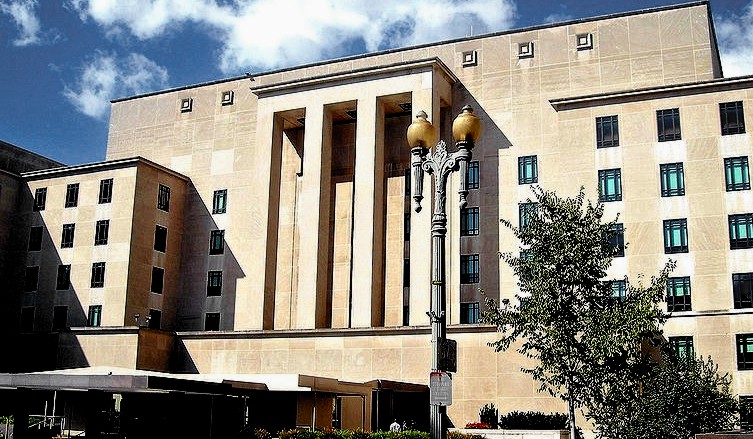
The State Department released seven cables a year ago. Click image above for details of the further release.
They were obtained under the Freedom of Information Act. These now provide a complete overview. The new cables are as bland and routine and unconcerned about Amanda Knox as ever.
There was no smoking gun among them, as the Knox PR campaign had so very much hoped for. The State Department will never move on this case based on how Italy handled it.
Remarkably, the increasingly bitter loser “Bruce Fisher” actually draws attention to the Knox PR campaign’s big disappointing loss with these bland new cables showing Italy has handled the case just fine in the Embassy’s eyes.
The poster of the first seven cables, History Buff, had hoped they would show the Rome Embassy was really concerned about Amanda Knox’s trial and sentence. No such luck. He seems to have hidden those cables now.
You can still read them here
Tuesday, April 12, 2011
Explaining The Massei Report: How Motive For The Crime Is Addressed By Judge Massei
Posted by James Raper
The March 2010 Trial Sentencing Report
The Massei Report in the main I thought was excellent. He was incisive with his logic, particularly, though not exclusively, with regard to the staging of the break in and how that necessarily meant that Amanda was present at the scene when the murder was committed.
However, I thought that he was rather feeble in his coverage of the defendants’ motives as to the attack which led to this brutal murder.
Perhaps he thought it better to stick with the indisputable evidence. Since this pointed to a sex attack he surmised that Guede had a go at Meredith first, and then - because the stimulation was too much for them - he was joined by Amanda and Raffaele. This works but does seem a bit weak.
Micheli, the judge who committed Amanda and Raffaele to stand trial, was more certain in his mind as to the roles played by these three. He said that there was “an agreed plan”, “to satisfy sexual instincts” with “murderous intent” and that effectively Amanda was the instigator and catalyst.
Motive is largely an area of speculation but it is surely possible to draw inferences from what we know? As Micheli did. The Appeal Court and ultimately The Supreme Court of Cassation may well adopt the same reasoning and conclusion - maybe go further.
And there were, to my mind, undoubtedly many factors at work, and it is these which I wish to address. I have always been interested in the possible dynamics of just how these three came to murder poor Meredith. Pro-Knox campaigners once made much of “No Motive”. Now not so much, because the issue draws people in to a discussion of the evidence and of Amanda’s personality.
For instance, Massei asks, though he says we can not know, had Amanda egged Guede on as to the “availability” (my word, not his) of Meredith during or prior to their presence at the Cottage?
Frankly the answer to that has to be “yes” since it is a bit difficult to figure out why Amanda and Raffaele would otherwise wish Guede to join them at the cottage. I doubt that Amanda and Raffaele would have wanted Guede around if they were just going there to have an innocent cuddle and sex and to smoke cannabis, as Massei implies. The evidence is that Raffaele hardly knew Guede and in the presence of Amanda was very possessive about her. If he had known of Guede’s interest in Amanda, he would have been even less keen to have Guede around.
Also, if all was so innocent beforehand, then why would Guede have tried it on with Meredith, and then pressed the situation in the face of her refusal to co-operate? Knowing that there were two others there who could have come to her assistance?
The answer is of course that Guede knew full well in advance that there would be no problem with Amanda and Raffaele. He had been invited there, and primed to act precisely in the way he did, at least initially. Why? Well there is plenty of evidence as to why Amanda, in her mind, may have been looking for payback time on Meredith. Come to that later.
What does not get much attention in the Massei Report, other than a terse Not Proven at the end, is the matter of Meredith’s missing rent money and credit cards and whether Amanda and Raffaele stole them. It is as if the Judge (well, the jury, really) felt that this was a trivial issue that brought nothing much to the case, and thus it was not necessary to give it much attention. And indeed there is no summation of or evaluation of that evidence.
Now that does surprise me. Of course there may have been some technical flaw with the charge and the evidence. But in the absence of any comment on this then we do not know what that may be.
What I do know is that the matter, if proven, is not trivial. A theft just prior to the murder significantly ups the stakes for Amanda and Raffaele, and produces a dynamic, which, threaded together with a sexual assault, makes for a far more compelling scenario to murder. It also leads one to conclude that there was a greater degree of premeditation involved: not premeditation as to murder, but as to an assault, rather than the more spontaneous “let’s get involved” at the time of the sex attack as postulated by Massei.
What is the evidence? What evidence was before the court? I do not yet have access to trial records. Therefore I stand to be corrected if I misrepresent the evidence, or if my interpretation of it does not met the test of logic.
There were two lay witnesses to whom we can refer. The first was Filomena Romanelli, the flatmate and trainee lawyer. If there was anyone who was going to ensure that the rent was paid on time, it would have been her. She gave evidence that, the rent being due very soon, she asked Meredith about her contribution of 300 euros, and was told by Meredith that all was OK because she had just withdrawn 200 euros from her bank. Filomena assumed from Meredith’s reply that the balance was already to hand.
Is there a problem with this evidence? Is it hearsay and thus inadmissible under Italian law?
Perhaps it is not enough by itself because of course had Meredith not in fact withdrawn the money from her bank, or sufficient funds to cover the stated amount, then that would be a fatal blow to that part of the theft charge. Her bank manager was summoned to give evidence, essentially to corroborate or disprove Filomena’s testimony. I do not know what exactly that evidence was. One would assume that at the very least it did not disprove her testimony. Had it done so, that would as I have said been fatal. It is also unbelievable that Massei would have overlooked this in the Report. I am assuming that Meredith did not tell a white lie, and that the bank records corroborate this.
There may of course be an issue of timing as I understand that the bank manager told the court that transactions at a cash machine are not necessarily entered on the customer account the same day . However that does not seem to me to be significant.
One must also think that the bank manager was asked what other cash withdrawals had been made if the credit cards were taken at the same time as the money.
I understand that there is of course a caveat here: my assumptions in the absence of knowing exactly what the bank manager’s evidence was.
It would be useful also to know how and when the rent was normally paid. It sounds as if it was cash on the day the landlord came to collect.
We do know that the police did not find any money, or Meredith’s credit cards. Had Meredith, a sensible girl, blown next month’s rent on a Halloween binge? Unlikely. So somebody stole it. And the credit cards? Again, just as with the fake break in, when according to Amanda and Raffaele nothing was stolen, who and only who had access to the cottage to steal the money? Yes, you have guessed it. Amanda, of course.
Does the matter of missing rent money figure anywhere else? There is the evidence of Meredith’s phone records which show that a call was placed to her bank late on the evening of her murder just prior to the arrival of Amanda, Raffaele and Guede. Why? I have to concede that there is no single obvious reason and that it may be more likely than not that the call was entirely unintentional.
But if, as may seem likely, the credit cards were kept with her handbag, and the money in her bedroom drawer, then on discovering that her money was missing she may have called her bank in a funk, only to remember that the cards were safe and that no money could be withdrawn from her account.
The missing money also figured in the separate trial of Guede. He made a statement which formed the whole basis of his defence. Basically this was that he had an appointment with Meredith at the cottage, had consensual foreplay with her, and was on the toilet when he heard the doorbell ring etc, etc. What he also added was that just before all this Meredith was upset because her rent money had disappeared and that they had both searched for it with particular attention to Amanda’s room.
Now why does Guede mention this? Remember this is his defence. Alibi is not quite the right word. He had plenty of time to think about it or something better. His defence was moulded around (apart from lies) (1) facts he knew the police would have, ie no point denying that he was there, or that he had sexual contact with Meredith: his biological traces had been left behind; and (2) facts known to him and not to the police at that stage, ie the money, which he could use to make his statement as a whole more credible, whilst at the same time giving the police a lead. He is shifting the focus, if the police were to follow it up, on to the person he must have been blaming for his predicament, Amanda.
If all three, Amanda, Raffaele and Guede, went to the cottage together, as Massei has it, then Guede learns about the missing rent money, not in the circumstances referred to in his statement, but because Meredith has already discovered the theft, and worked out who has had it, and challenges Amanda over it when the three arrive. Perhaps this is when Guede goes to the toilet and listens to music on his Ipod. After all he is just there for the sex and this is all a distraction.
Although Micheli thought Guede was a liar from start to finish, he did not discount the possibility that Guede was essentially telling the truth about the money. Guede expanded upon this at his appeal, telling the court that Amanda and Meredith had an argument and then a fight over it. It is a thread that runs through all his accounts, from his Skype chat and initial statements in Germany to his final appeal.
Guede’s “evidence” was not a factor in the jury’s consideration at Amanda’s and Raffaele’s trial. Although he was called to give evidence he did not do so. Now his “evidence” and the findings and conclusion of the courts which processed his case come in to play in the appeal of Amanda and Raffaele.
When were the money and credit cards stolen?
I have to accept that, as to the money, at any rate a theft prior to the murder is critical to sustain the following hypothesis. The credit cards were in any event probably taken after the attack on Meredith.
According to Amanda and Raffaele they spent Halloween together at Raffaele’s, and the next day went to the cottage. Meredith was there, as was Filomena. Filomena left first, followed by Meredith to spend the evening with her friends, and Amanda and Raffaele left some time afterwards.
So Amanda and Raffaele could have stolen the money any time after Meredith left and before she returned at about 9.30pm - the day of her murder. Incidentally Filomena testified that Meredith never locked the door to her room except on the occasions she went home to England. Meredith was a very trusting girl.
What motive had Amanda for wanting the money, apart from the obvious one of profit?
There are numerous plausible motives.
To fund a growing drugs habit which she shared with Raffaele? Not an inconsiderable expense for a student. Both Amanda and Raffaele explained during questioning that their confusion and hesitancy was due to the fact that they had been going rather hard on drugs. Mignini says that they were both part of a drugs crowd.
Because her own financial circumstances were deteriorating, and to fund her own rent contribution? She was probably about to be sacked at Le Chic, where she was considered by Lumumba to be flirty and unreliable, and to add insult to injury would likely be replaced by Meredith. In fact Meredith was well liked and trusted by all, whereas Amanda’s star was definitely on the wane.
But maybe Amanda just also wanted to get her own back on Meredith.
Filomena testified that Meredith and Amanda had begun to have issues with each other.
Here are some quotes from from Filomena in “Darkness Descending”.
At first they got on very well. But then things began to take a different course. Amanda never cleaned the house, so we had to institute a rota… then she (Amanda) would bring strangers home… Meredith said she was not interested in boys, she was here to study.
Meredith was too polite to confront Amanda, but she did confide in her pal, Robyn Butterworth. Robyn winced in disbelief when Meredith said that the pair had quarreled, because Knox often failed to flush the toilet, even when menstruating. Filomena began noticing that Amanda could be odd, even mildly anti-social.
It seems that Amanda did not like it when she was not the centre of attention. It was observed that, comically if irritatingly, she would sing loudly if conversation started to pass her by, and when playing her guitar would often strum the same chord over and over again.
On the evening of Halloween, Amanda texted Meredith enquiring as to whether they could meet up. But Meredith had other arrangements. Meredith appeared to be having a good time, whereas Amanda was not.
Indeed there has been much speculation that Amanda has always had deep seated psychological problems and that after just several weeks in Perugia her fragile and damaged ego was tipping towards free fall.
With Meredith’s money, both Amanda and Raffaele could have afforded something a little stronger than the usual smoke, and I speculate that they spent the late afternoon getting stoned.
Of course Amanda was still an employee of Lumumba, and she was supposed to turn up that evening for work, but perhaps she no longer cared all that much for the consequences if she did not.
Again I speculate, that she, with or without Raffaele, met Guede at some time - perhaps before she was due at work, perhaps after she learnt that she was not required by Lumumba - and discussed Meredith’s “availability” and agreed to meet up again on the basketball court at Grimana Square.
The notion that Amanda and Guede hardly knew each other seems implausible to me. We know that they met at a party at the boys’ flat at the cottage. Guede was friends with one of those boys and was invited there on a number of occasions. He was ever-present on the basketball court in Grimana Square, which was located just outside the College Amanda and Meredith attended, and just metres from the cottage. He was known to have fancied Amanda, and Amanda was always aware of male interest.
What else did Amanda and Raffaele have in mind when arranging the meeting or when thinking about it afterwards?
Guede was of course thinking about sex and that Amanda and Raffaele were going to facilitate an encounter with Meredith later that evening. However Amanda and Raffaele had something else on their minds. The logic of their position vis a vis Meredith cannot have escaped them. They had taken her money whilst she was out.
Had she not already discovered this fact then she would in any event be back, notice the money was missing and would put 2 and 2 together. What would happen? Who would she tell? Would she call the police? How are they going to deal with this? Obviously deny it, but logic has its way, and the situation with or without the police being called in would be uncomfortable.
They decided to turn the tables and make staying in Perugia uncomfortable for Meredith? Now the embarrassing, for Meredith, sexual advances from Guede were going to be manipulated by them in to a sexual humiliation for Meredith. Meredith was not going to be seriously harmed, but as and when they were challenged by Meredith over the missing money, as inevitably they would be, she was to be threatened with injury or worse. Knives come in useful here.
Amanda may have fantasized that Meredith would likely then give up her tenancy at the cottage, perhaps leave Italy. Whether that looks like the probable and likely outcome, I leave you to judge, but the hypothesis is that they were starting to think and behave irrationally and that this was exacerbated by the use of drugs.
In the event there came a point when neither Amanda nor Raffaele had any other commitments anyway. They got to the basketball court. They waited for Guede.
We know Amanda and Raffaele were on the basketball court the evening of the 1st November. This is because of the evidence of a Mr Curatolo, the second lay witness. He was not precise about times but thought that they were on the basketball court between 9.30pm and 10pm and may have left around 11.00 - 11.30pm and then returned just before midnight.
In any event he testified to seeing Amanda and Raffaele having heated arguments, and occasionally going to the parapet at the edge of the court to peer over. What were they looking at? Go to the photographs of Perugia on the True Justice for Meredith website, and you will see. From the parapet you get a good view of the iron gates that are the entrance, and the only entrance as I understand it, to the cottage.
So why the behaviour observed by Mr Curatolo? They may have been impatient waiting for Guede to arrive. Were they actually to go through with this? Was Meredith at home, alone, and had she found the money was missing and had she called the police or tipped off someone already? Who was hanging around outside the entrance to the cottage and why?
There was, apparently, a car parked at the entrance, a broken down car nearby with the occupants inside awaiting a rescue truck, and the rescue truck itself, all present around 11.00pm. Amanda and Raffaele did not wish to be observed going through the gates with these potential witnesses around.
We of course cannot know for certain what went on in the minds of Amanda and Raffaele between the time of them leaving the cottage and their departure from the basketball court to return to the cottage. It has to be speculation, but there is a logical consistency to the above narrative if they had stolen Meredith’s money earlier that day, and their meeting up with Guede just before leaving the basketball court does not look like a coincidence.
From there on in to the inevitable clash between Amanda and Meredith over the money.
It is my opinion that at the cottage Amanda came off worse initially: that she got caught in the face by a blow and suffered a nose bleed.
Experts Stefanoni and Garofano both say that there was an abundant amount (relatively speaking) of Amanda’s blood in the bathroom washbasin, and to a lesser extent the bidet. Whereas most of Amanda’s blood in the bathroom was mixed with Meredith’s, the blood on the washbasin tap was Amanda’s alone. Both of a quality and quantity to discount menstrual (from washed knickers) or bleeding from ear-piercing. Their conclusion was that Amanda bled fairly profusely though perhaps briefly at some stage.
Possibly Amanda may have cut her feet on glass in Filomena’s bedroom but if so it’s difficult to see how blood from that ends up as a blob on the basin tap and in the sink, and cut feet are painful to walk on and she did not display any awkwardness on her feet the next day.
Amanda’s blood may have come from a nick by a blade to her hands. I think the nick would be obvious the next day. If so, she was not hiding it. She was photographed the next day outside the cottage waving her hands under the noses of a coterie of vigilant cops.
She might have got a bloody nose during the attack in Meredith’s bedroom save that there is no evidence of her blood there.
On the other hand if she got into a tussle with Meredith (say in the corridor outside their rooms and where there was little room for other than the two to be engaged) and was fended off with a reflex blow that accidentally or otherwise connected with her nose, Amanda’s natural reaction would be to disengage immediately and head for the bathroom sink to staunch the flow of blood.
A nose-bleed need not take too long to staunch, especially if not serious and if there is no cut (certainly none being visible the next day). Just stuff some tissue up the offending nostril. A nose bleed is not necessarily something of which there would be any sign the next day.
Raffaele fusses around her, whilst Rudy briefly plays peacemaker. But Amanda is boiling. As furious with Raffaele and Guede as she is with Meredith. She eggs Guede on and pushes him towards Meredith. Raffaele proudly produces his flicknife, latent sadistic instincts surfacing.
Is a scene like this played out inside the cottage or outside? I think of the strange but sadly discredited tale told by Kokomani.
In any event motive is satiated and the coil, having been tensed, is sprung for the pre-planned, but now extremely violent, hazing of poor Meredith.
I am also thinking here of Mignini’s “crescendo of violence” and where a point is reached where anything goes ““ where there is (from their warped perspectives) almost an inevitability or justification for their behaviour. A “Meredith definitely needs teaching a lesson now!” attitude.
Psychology is part of motive and there is much speculation particularly with regard to Amanda and Raffaele. They have both been in prison for well over three years now and during this time psychological assessments will certainly have been carried out.
Based on specific incidents and and general patterns of behaviour, speech and language, and demeanour, some preliminary conclusions will have been reached correlated with the facts of the crime.
If their convictions are upheld, these assessments may be relevant to sentence insofar as they shed light on mitigation and motive.
Thursday, March 03, 2011
The DEFENSE Not Italian Officials Leaked About Knox HIV Test In Capanne DRAFT
Posted by Michael
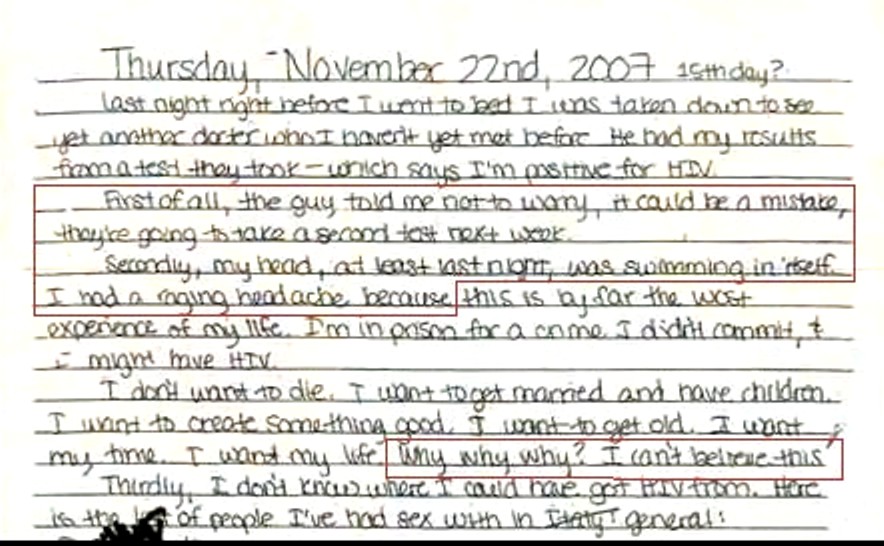
The several wrong facts in the Lifetime movie, especially of timeline, perhaps balanced one another out, and seemed to leave many viewers sensing the possibility of guilt.
However, there was one very serious wrong claim in the movie and in the following documentary which implied criminal action on the part of the Capanne Prison medical staff and prosecutors and may have aroused a lot of false sympathy for Amanda Knox.
The film depicted Amanda knox being told by the doctor at Capanne that in a routine test she tested positive for HIV and to write down a list of her previous partners. Later, a confrontation was shown between an angry Amanda and the doctor (which never happened) when he told her she was all clear.
In reality, the doctor told Amanda at the start that the test was probably a false positive and that she shouldn’t worry and that another test would be run. The doctor never instructed Amanda to write out a list of her previous partners. And the prosecutors never leaked that list.
In Amanda Knox’s own words, you can read above how it went down: She chose herself to create the sex partners list.
The myth in the movie of how the sex partners list was created and spread around was then later compounded by the ‘Knox friendly’ Lifetime documentary. That also claimed Amanda Knox was told to write down her list of partners by the doctor and then her diary was leaked by prosecutors to the public.
We know this to be false. We know that it was instead Amanda Knox’s own lawyers that leaked the diary with the sex partners list (to journalists like Barbie Nadeau) and the family effort that leaked it to people like Frank Sfarszo (who duly published Amanda’s diary page on previous sexual partners), and Candace Dempsey, and even tried to leak it to us!
Amanda’ Knoxs family know the truth of this, but have not yet come out and corrected a seriously wrong pervasive impression. And Lifetime repeated the lie of the sex partners list, leading millions to believe the ILE deliberately terrified, tricked and humiliated Amanda Knox.
But they didn’t. Amanda Knox herself showed it was not so.
Lifetime’s Misleading Portrayal Of Knox HIV Leak: One Of Many Dishonest Knox-Team Leaks
Posted by Michael
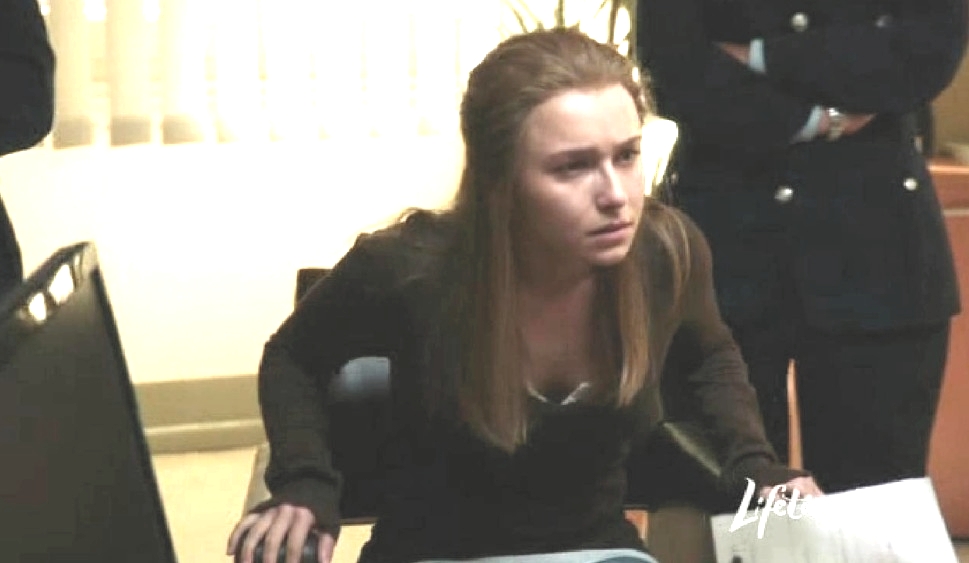
Above and below: images from the two misleading scenes
1. Movie Advances HIV & Sex Partners List Hoax
The Lifetime movie nicely depicted Meredith and Dr Mignini, and was not tough on Knox, though it seemed to leave many viewers sensing the possibility of guilt.
However, there were several seriously wrong scenes in the Lifetime movie, and also in the associated Lifetime documentary. Two scenes advanced the HIV-test and sex-partners-list hoax.
- 1. In a first long and emotional scene, the film depicted Amanda Knox being told by the doctor at Capanne that in a routine test she tested positive for HIV. It implied the test was a form of pressure. It showed Knox being told she should write down a list of her previous partners.
2. In a second long and emotional scene, the film depicted a confrontation between an angry Amanda and the doctor when he told her she was all clear. And thereafter depicted that it was the the prosecution that leaked the sex partners list.
These implied criminal actions on the part of both the Capanne Prison medical staff and the prosecutors, and aroused a lot of false sympathy for Knox.
2. The Hard Facts About Knox’s HIV Testing
1. Lifetime V Reality: Knox Had Herpes When She Was Tested
Lifetime simply depicted Amanda Knox being told by the doctor at Capanne that she tested positive for HIV. It implied the test was unusual.
In fact, on her admittance to Capanne Prison, Knox was simply routinely tested for HIV and some other possible conditions, as all prisoners are, for their own good.
Knox had herpes at the time, visible on her lip in many photographs, and herpes can result in a false positive result for HIV.
2. Lifetime V Reality: Proof Knox Warned Positive Test Maybe False
Lifetime did not depict Knox being warned about false positives. But Knox’s diary reads:
Last night before I went to bed I was taken down to see yet another doctor who I haven’t yet met before. He had my results from a test they took which says I’m positive for HIV.
First of all the guy told me not to worry, it could be a mistake, they’re going to take a second test next week….
3. Lifetime V Reality: Knox Herself Creates Sex Partners List
Lifetime claimed Amanda Knox was told to write down her list of partners by the doctor.
But in Amanda Knox’s own words, you can read how it went down: She chose herself to create the sex partners list. The doctor never instructed Amanda to write out that list. Her diary reads:
Thirdly, I don’t know where I could have got HIV from. Here is the list of people I’ve had sex with in Italy [strike Italy] general:...
4. Lifetime V Reality: There Was No Angry Confrontation
Lifetime depicts a yelling, pointing Knox, who has to be restrained.
The doctor merely conveyed the news of a negative results and Knox cheerfully went off. He had no ill intent, she did not get angry, and no accusations were made.
3. The Hard Facts About Who Leaked The Results & List
Lifetime implied that Knox’s diary with the list of partners was leaked by the prosecutors to the public.
We know this to be false. We know that it was instead Amanda Knox’s own lawyers that leaked the diary with the sex partners list (to journalists like Barbie Nadeau). And that the family effort leaked it to people like Frank Sforza (who duly published Amanda’s diary page on the previous sexual partners), and Candace Dempsey, and even tried to leak it to us!
Amanda’s lawyers leak like sieves, always have, and they’ve rarely, if ever, asked Amanda permission to do so. It isn’t actually required, since she’s already given them permission to act on her behalf. In a way, it’s a bit like electing a politician. Once you’ve elected them, they don’t have to come back to you (the electorate) for permission every time they want to pass a bill, create a new policy or enter into negotiations.
When we had our own reporter (Stewart Home) attending the trial, the defence happily showed him anything in the case file he asked to see. In fact, many times they offered without his having to even ask.
In addition, Amanda’s family have been doing quite a lot of ‘leaking’ themselves. Frank Sforza and Candace Dempsey got most of their data from them, as did Charlie Wilkes, Mark Waterbury and Bruce Fischer. And this leaking by the family started long before the trial.
It needs to also be pointed out, Sollecito’s family and lawyers have also been doing their share of leaking.
However, the Knox family and their followers have been only too happy to publicly blame all this leaking on Italian law enforcement (ILE) and cite this as another injustice against their daughter. The US media have been only too happy to carry these accusations, without question. This is how the ILE have been framed and it stinks.
4. Relevant Misleading Scenes In The Lifetime Film
Top and below: the first partly imaginary scene
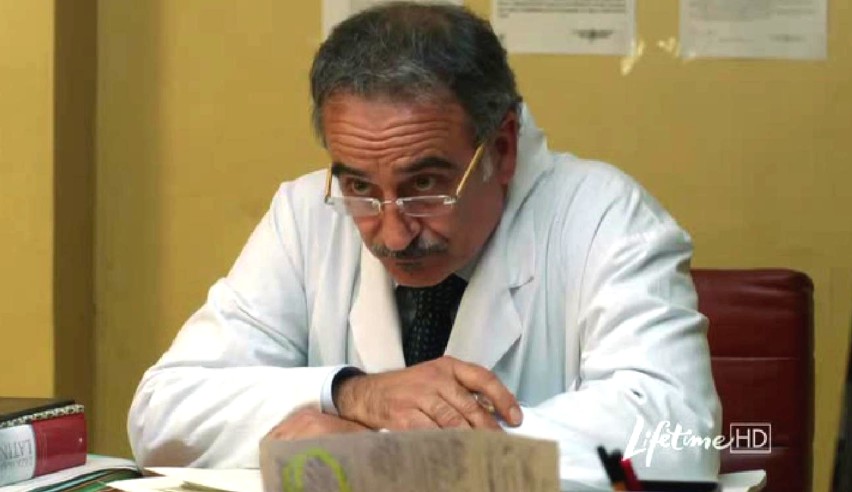
Above and below: the first partly imaginary scene
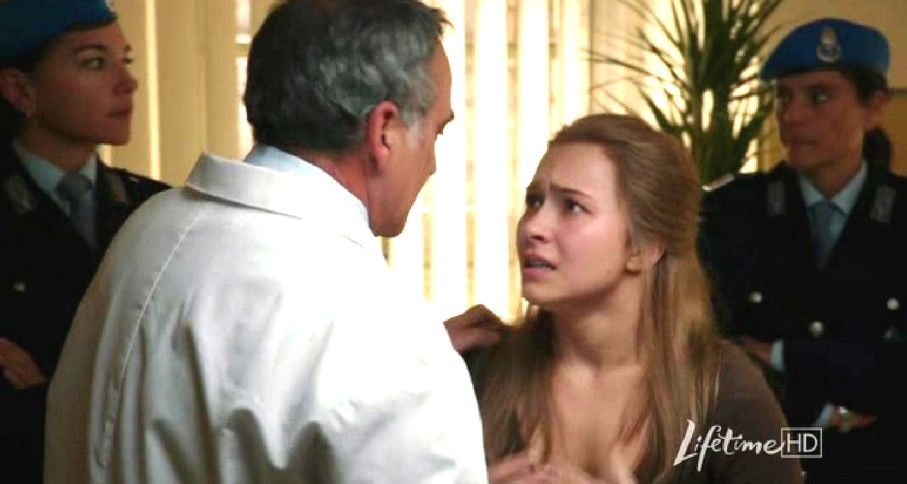
Below: the second very misleading scene
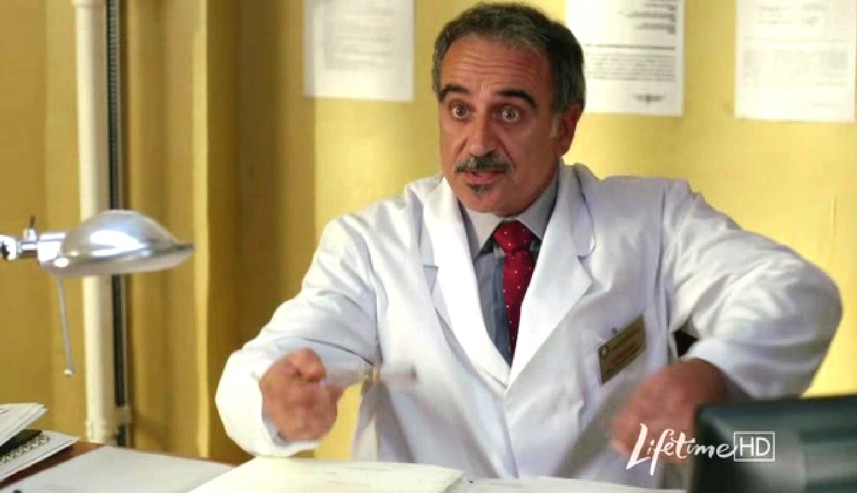
Below: the second very misleading scene
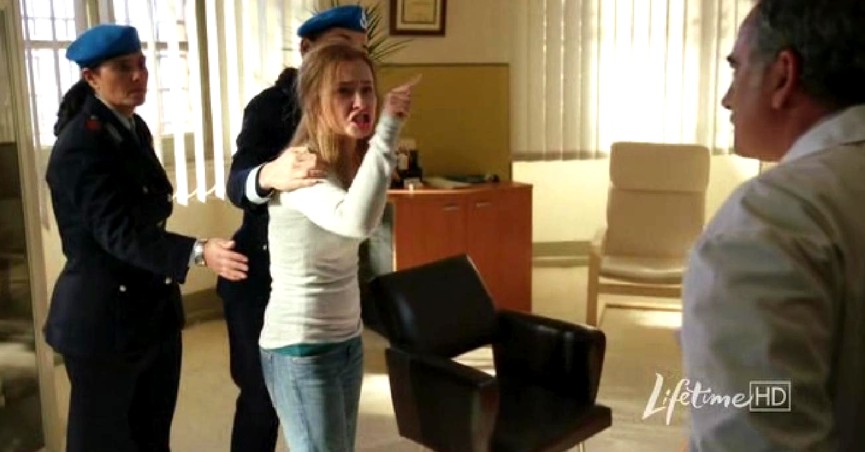
5. Bottom Line: One Of Many Knox-Team Hoaxes
Amanda’ Knoxs family know the truth of this, but have not yet come out and corrected a seriously wrong pervasive impression.
And Lifetime repeated the lie of the sex partners list, leading millions to believe the ILE deliberately terrified, tricked and humiliated Amanda Knox.
Tuesday, February 22, 2011
Open Questions: An Experienced Trial Lawyer Recommends How To Zero In On the Truth
Posted by SomeAlibi
Welcome
If you’ve come to this website because of the Lifetime movie of Meredith Kercher and Amanda Knox, then welcome.
Like all of us who come to this case, you have one key question: did they do it? The movie you’ve just watched is equivocal on that matter and perhaps didn’t help you at all.
On the internet, you will find people who are passionate in their defence of Amanda Knox and Raffaele Sollecito and you will find people who are passionate in their support of the prosecution.
My own arrival
Placing my own cards on the table here: as a twenty-plus year practising trial lawyer, I am firmly a part of that latter camp. But it wasn’t always that way.
It was information ““ evidence ““ that changed my views. What became very clear to me, early on, was that very few people in the English-speaking world are aware of anywhere near all of the evidence in this case.
I had thought I had grasped the core of the case, but I did not. The case is deep and complex and like many criminal cases, the complete facts behind it have been only sketchily reported in the media. The movie you may have just watched only skirts the real reasons the jury convicted.
The unanimous jury
I am sure that we all agree that no jury, in any murder case, given the awesome responsibility of adjudicating on (young) people’s lives for a multi-decade period of imprisonment, condemns people lightly.
It should be a matter of logic that the evidence presented against the accused must have been deep and satisfied the 6 lay jurors and 2 judges on the case for them to pronounce that huge judgement. That doesn’t mean that there couldn’t be the possibility of a mistrial, but clearly the evidence presented must have been substantial.
In this, we’ve already hit the first problem. Some supporters of Amanda Knox and Raffaele Sollecito will tell you there’s no evidence against them.
This is patently silly. No jury ever convicts people and sends them to prison for 24 plus years without being quite convinced of the case against them. Miscarriages of justice do happen, but the idea that there is “no evidence” can be summarily dismissed.
The only question is whether the evidence is sufficient, true and accurate.
The voluminous evidence
So is the evidence enough to convict beyond a reasonable doubt? The six lay jurors and two professional judges thought so, clearly. What you realise, when you come to the facts of the case, is that the evidence is based not around a single key event but on multiple points.
It can be astonishing to realise that the case is based not only on DNA evidence but also on cellphone evidence and computer records and further yet on multiple conflicting and contradicting versions of what happened that night from the mouths of the accused, not to mention falsely accusing an innocent man of responsibility for murder causing his incarceration.
The wealth of evidence is actually extremely unusual. It goes way beyond the quite similar Scott Peterson case.
The Massei Sentencing Report
What is absolutely new to the English speaking legal world is that the reasoning for the conviction can be read in an extremely detailed 440+ page report online. Bilingual posters at the Perugia Murder File Forum many of whom who are also key posters at TJMK translated the entire document into English over several months last year.
It was my privilege to play an extremely small part in that work. People from four different continents with backgrounds in forensic science, law, academia and a host of other disciplines participated.
You can read an effective executive summary by clicking on the Massei Report link at top here and reading the conclusions from page 388 onwards:
The Knox PR campaign
If you are new to this case, you will likely be shocked how much evidence there is against the convicted parties. Amanda Knox’s family have spent over $1m and involved a professional PR agency called Gogerty Marriot to suggest otherwise in the English-speaking media.
You might wonder why an innocent person needs a million dollar PR campaign on their part. Make yourself a coffee and read the conclusions of the judge’s report. It will take you about 15 minutes. Up until you read this report, almost everything you watch, hear and read is PR spin and is quite deliberately positioned to make you believe there is no case.
When you complete it, I believe you will have a very different take. That 15 minutes could change your ideas about everything you thought you knew about the murder of Meredith Kercher.
Now for a quick tour of the evidence.
Some of the points of evidence
Consider as you read it what is your own possible explanation for each of the following:
- the fact that the wound pattern and the reconstruction of the attack, each presented at trial in extensive closed-court sessions, showed this absolutely had to be a pack attack;
- the DNA of Raffaele Sollecito on Meredith’s bra-clasp in her locked bedroom;
- the almost-entire naked footprint of Raffaele on a bathmat that in *no way* fits that of the other male in this case - Rudy Guede;
- the fact that Raffaele’s own father blew their alibi that they were together in Raffaele’s flat at the time of the killing with indisputable telephone records;
- the DNA of Meredith Kercher on the knife in Raffaele’s flat which Raffaele himself sought to explain as having been from accidentally “pricking” Meredith’s hand in his written diary despite the fact Meredith had never been to his flat (confirmed by Amanda Knox);
- the correlation of where Meredith’s phones were found to the location of Raffaele Sollecito and Rudy Guedes’s flats;
- the computer records which show that no-one was at Raffaele’s computer during the time of the murder despite him claiming he was using that computer;
- Amanda’s DNA mixed with Meredith Kercher’s in five different places just feet from Meredith’s body;
- the utterly inexplicable computer records the morning after the murder starting at 5.32 am and including multiple file creations and interactions thereafter all during a time that Raffaele and Amanda insist they were asleep until 10.30am;
- the separate witnesses who testified on oath that Amanda and Raffaele were at the square 40 metres from the girls’ cottage on the evening of the murder and the fact that Amanda was seen at a convenience store at 7.45am the next morning, again while she said she was in bed;
- the accusation of a completely innocent man by Amanda Knox again and again when under no pressure which she insisted on putting in writing;
- the fact of Knox’s claim that she was aggressively interrogated for days, although she did not even have the status of a witness, and signed every page of every typed record of her mild, mundane and quite limited questionings;
- the fact that during Knox’s very unconvincing performance on the witness stand in July 2009 she admitted she was treated well and was not abused;
- the fact that when Amanda Knox rang Meredith’s mobile telephones, ostensibly to check on the “missing” Meredith, she did so for just three seconds - registering the call but making no effort to allow the phone to be answered in the real world
- the knife-fetish of Raffaele Sollecito, and his formal disciplinary punishment for watching animal porn at his university so far from the wholesome image portrayed;
- the fact that claimed multi-year kick-boxer Raffaele apparently couldn’t break down a flimsy door to Meredith’s room when he and Amanda were at the flat the morning after the murder but the first people in the flat with the police who weren’t martial artists could;
- the extensive hard drug use of Sollecito as told on by Amanda Knox;
- the fact that Amanda knew details of the body and the wounds despite not being in line of sight of the body when it was discovered;
- the lies of Knox on the witness stand in July 2009 about how their drug intake that night (“one joint”) is totally contradicted by Sollecito’s own contemporaneous diary;
- the fact that after a late evening’s questioning, Knox wrote a 2,900 word email home which painstakingly details what she said happened that evening and the morning after that looks *highly* like someone committing to memory, at 3.30 in the morning, an extensive alibi;
- the fact that both Amanda and Raffaele both said they would give up smoking dope for life in their prison diaries despite having apparently nothing to regret;
- the fact that when Rudy Guede was arrested, Raffaele Sollecito didn’t celebrate the “true” perpetrator being arrested (which surely would have seen him released) but worried in his diary that a man whom he said he didn’t know would “make up strange things” about him despite him just being one person in a city of over 160,000 people;
- the fact that both an occupant of the cottage and the police instantly recognised the cottage had not been burgled but had been the subject of a staged break-in where glass was *on top* of apparently disturbed clothes;
- the fact that Knox and Sollecito have feuded quite publicly ever since November 2007 and have shown far more anger toward one another than either has ever shown toward Guede;
- the fact that Knox and Sollecito both suggested each other might have committed the crime and Sollecito TO THIS DATE does not agree Knox stayed in his flat all the night in question;
- the fact of the bizarre behaviour of both of them for days after the crime;
- the fact that cellphone records show Knox did not stay in Sollecito’s flat but had left the flat at a time which is completely coincidental with Guede’s corroborated presence near the girl’s flat earlier in the evening;
- the fact that Amanda Knox’s table lamp was found in the locked room of Meredith Kercher in a position that suggested it had been used to examine for fine details of the murder scene in a clean up;
- the unbelievable series of changing stories made up by the defendants after their versions became challenged;
- Knox’s inexplicable reaction to being shown the knife drawer at the girl’s cottage where she ended up physically shaking and hitting her head despite being joyful earlier at the police station.
In conclusion
This list is not exhaustive. It goes”¦ on”¦ and on”¦ and on”¦ And yet, those supporting Knox will tell you that’s all made up, all coincidental.
Really? Does the weight of all that evidence sound made up to you?
If so, it must be the most over-rigged criminal case in the history of crime. Unlikely beyond all and any reasonable doubt.
The judge’s report explains why the jury found the defendants guilty. I truly expect you will be astonished at the amount of evidence if all you’ve done is watched a film or read a few press reports.
For any questions thereafter, please join us and post them on truejustice.org or perugiamuderfile.org . You’ll find here a host of good people who are all working on a totally volunteer basis in memory of the only victim of this crime.
Meredith Susanna Cara Kercher. RIP.
Thursday, February 10, 2011
Report Of The Decay Of The Hard Pro-Knox Party Line In West Seattle
Posted by Peter Quennell
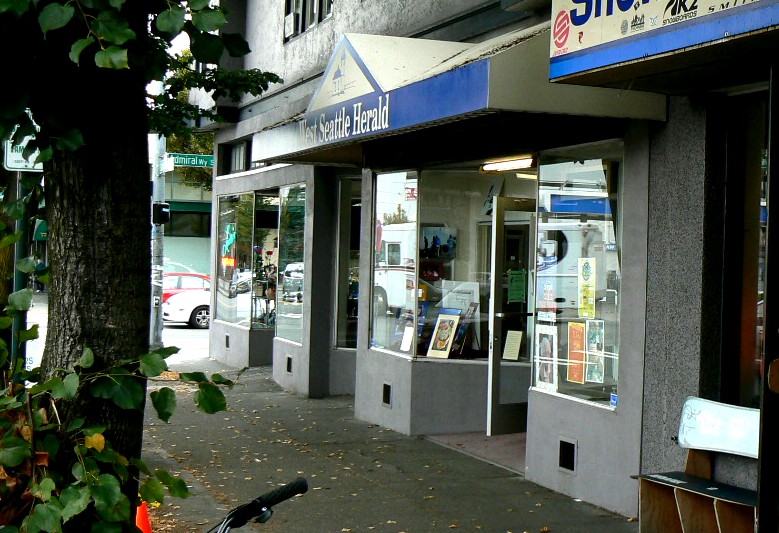
Former HQ of West Seattle Herald
West Seattle Groupthink Under Strong Fire
The Seattle Salmon reports with some amusement on how the residents are increasingly speaking out.
They whisper at the local library branch, nod to each other in line at the Morgan Junction Starbucks, and even occasionally email their true feelings to each other. What is this secret society? It’s not the Masons, Scientologists or even the wily Northwestern Republicans.
No, this fearful group is West Seattleites who think Amanda Knox did it. By “it,” they are referring to the 2007 murder in Italy of which she was convicted. Knox was raised in West Seattle and the community has rallied around her claim of innocence with a fervor that straddles the militant/cult divide.
But some in the community are not so sure and not so talkative about their doubt. One resident who demanded anonymity told the Seattle Salmon, “It’s like a police state out here. You have to go to the legal defense fundraisers ““ like six last year ““ or else you are ostracized at the Westcrest Off-leash area.”
Another said, “The groupthink is terrifying. You step outside of it and you’re like the stupid Regular Seattleite who jaywalks through the all-way crosswalk at The Junction ““ you’re all alone and danger could come at you from any direction. Plus they’d light your ass up on the West Seattle Blog. You’d have to move.”
Perhaps no surprises there. It has been a long time since pro-Steve-Shay comments on the West Seattle Herald have been in the majority. Yesterday he made this ludicrous claim.
Meredith’s father, John, who believes Knox is guilty and has a lawyer in the courtroom fighting to insure she and her boyfriend Raffaele Sollecito remain in jail.
These were the first two responses.
John Kercher’s lawyer is not ‘fighting’ anyone or anything. He has a legal duty to provide representation at the automatic appeal which Italy’s very liberal criminal justice system provides to all convicted criminals.
Your inflammatory, arrogant coverage of this legal process stinks. The US State Department doesn’t think there was anything wrong with the year-long legal process which convicted Knox and Sollecito of torture and murder, and neither do their victim’s family. Again, this doesn’t mean they are ‘fighting’, so grow up.
Mr. Shay atypically made only one glaring distortion in this article; The Kercher family lawyer is involved in the appeals process not to insure that Ms. Knox stay in jail, but rather to make sure the prosecution’s case is presented fairly and objectively, as was certainly done in the court’s verdict.
Not to make the lawyer sound one sided and intent on a path; there are way too many like Shay in the pro innocent Knox camp; this population has been known to lie and distort facts so as to exculpate their darling “West Seattle bred” Knox.
Nice work West Seattle.

